19. THE SETTLING IN OF THE COLD WAR

THE NIXON ERA
CONTENTS
 The European Economic Community The European Economic Community
begins its expansion
 The American retreat from Vietnam The American retreat from Vietnam
 The Kent State tragedy The Kent State tragedy
 Vietnam Veterans Against the War Vietnam Veterans Against the War
 The Pentagon Papers The Pentagon Papers
 Détente with the Chinese and Soviets Détente with the Chinese and Soviets
 Watergate Watergate
 Another Arab-Israeli War (October 1973) Another Arab-Israeli War (October 1973)
 Congress brings down Nixon – and Congress brings down Nixon – and
Vietnam
 The horrible aftermath of Congress's The horrible aftermath of Congress's
"anti-imperialism" in Indochina
 A very sad American Bicentennial (1976) A very sad American Bicentennial (1976)
 America moves from Christianity America moves from Christianity
towards Secularism
The textual material on page below is drawn directly from my work
A Moral History of Western Society © 2024, Volume Two, pages 319-332.
THE EUROPEAN ECONOMIC COMMUNITY BEGINS ITS EXPANSION |
With
Pompidou now President of France, the applications for admission to the
EEC by Britain, Denmark, and Ireland finally moved forward without a
French veto this time, being accepted in 1972 with actual membership
effective as of 1 January 1973.1
Norway, also scheduled to join at the same time, ultimately did not
join – because the Norwegian citizens, in a national plebiscite held
about the matter in late September of 1972, themselves rejected
the entry, 46.5% voting yes, 53.5% voting no.
1Greece
had been admitted as an EEC associate member in 1961 but had its
membership suspended in 1967 after a military coup established a Greek
government run by a group of colonels. In 1962 Spain had tried to
gain EEC membership, but was ultimately rejected in 1964 because the
country was still under Franco’s dictatorship. Greece would be
restored to membership in 1981 and Spain and Portugal would be admitted
in 1986 … those countries no longer under dictatorial rule.
THE AMERICAN RETREAT FROM VIETNAM |
Clearly,
Vietnam was the American all-consuming issue of those years.
Because it was the biggest issue going into America’s national
elections in 1968, Johnson had cut back considerably the bombing of
North Vietnam in the hopes of moving the Paris peace talks
forward. However, not having succeeded in that political move,
just prior to those elections he stopped the bombing altogether – in
order to push South Vietnamese President Thieu to accept some of
Johnson’s peace proposals … and to improve Humphrey’s image going into
the elections.
Actually, Nixon had secretly informed Thieu not to accept Johnson’s
proposals … that although Nixon had promised American voters a full
withdrawal of American troops from Vietnam, he would continue to give
full support to South Vietnam by other means. Johnson knew about
this Nixon proposal to Thieu (he had wiretapped both the South
Vietnamese embassy and members of Nixon’s staff) but dared not exploit
the fact for fear that his wiretapping would be discovered. Also
Humphrey was so certain of victory in the election that he did not
bother to bring the matter up at the time. Indeed, the Democrats
would later try to bring this matter forward as a serious violation of
the Logan Act making it illegal for a civilian to get involved in
diplomatic dynamics. But the effort did not go over well with
much of the American populace, who understood Nixon’s action to be a
very logical move of someone headed for the presidency. Thus the
matter was dropped.
But American politics at that point was intensely antagonistic …
political partisanship becoming vastly more important in the DC
political game than national consensus-building.
But moving forward on the Vietnam issue was not going to be easy for
Nixon. First of all, the South Vietnamese Army (ARVN) was going
to need some considerable development. And North Vietnam needed
to get the clear message that the withdrawal of American troops did not
mean the end of American interest in Vietnam. Strong airpower
protecting the South would remain in place. Consequently, at the
same time that he announced the schedule for the withdrawal of American
ground forces (to be completed fully just prior to the 1972 November
national elections) he also upped the bombing of Communist positions.
But he needed to get the South as well as the North to understand the
game plan. Convincing Thieu of his seriousness about the
withdrawal was as difficult as convincing the North Vietnamese about
the continuance of American commitment in the South.
To demonstrate his resolve to do things his way, in April of 1970, he
sent a huge military force into neighboring Cambodia to shut down the
Hồ Chí Minh Trail that had been used to bring vast amounts of supplies
from the North to the Viet Cong operating in the South.
Militarily, the Cambodian assault was a huge success.
|
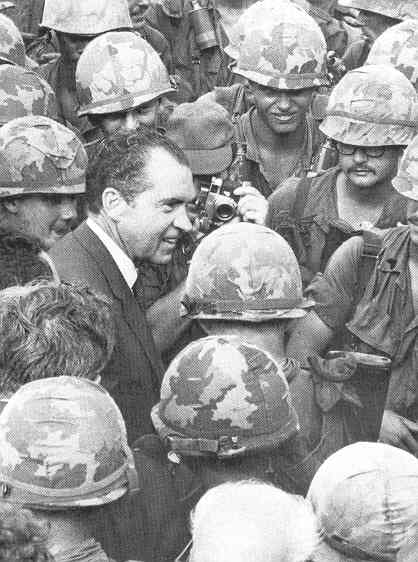 President Nixon and troops
in Vietnam
President Nixon and troops
in Vietnam
He stayed the course of troop withdrawal ... despite the lack of support from the American "Left"
But
politically, it served as the cause for another huge anti-war protest
in America, led here and there across the county in early May by the
SDS. Tragically, at Kent State University in Ohio, the National
Guard had been called out to protect the campus after the SDS had
students burn down the ROTC (Reserve Officers’ Training Corps) building
on campus … and an accidental firefight ended up with the National
Guard killing four students and wounding nine other students.
The outrage over the Kent State killings quickly led to protests held
at over 300 campuses across the country. But when the protests
spread to New York City, "hard hat" workers came out in violent protest
against the younger protesters … and things got very ugly. And
that divisive spirit showed itself again when Nixon was invited by
Billy Graham to speak at a combined 4th of July celebration and campus
crusade he was holding at the University of Tennessee … and protesters
tried to shout down his speech, only themselves to be shouted down by a
wildly supportive audience! American battle lines were deepening.
|
A horrible scenario occurred
on the campus of Kent State University
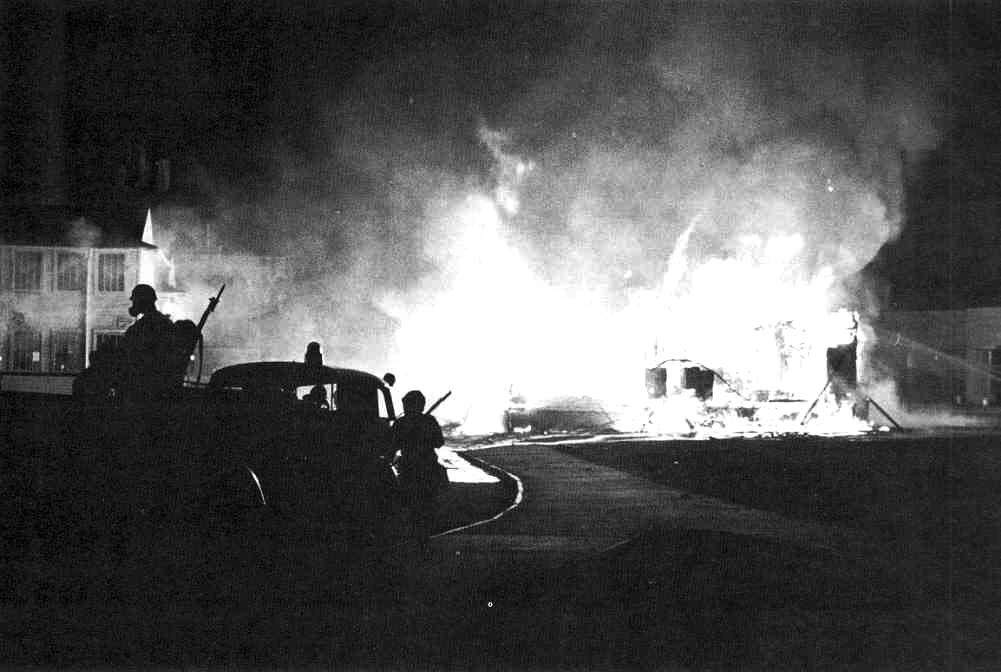
The burning ROTC building
at Kent State University - May 2, 1970
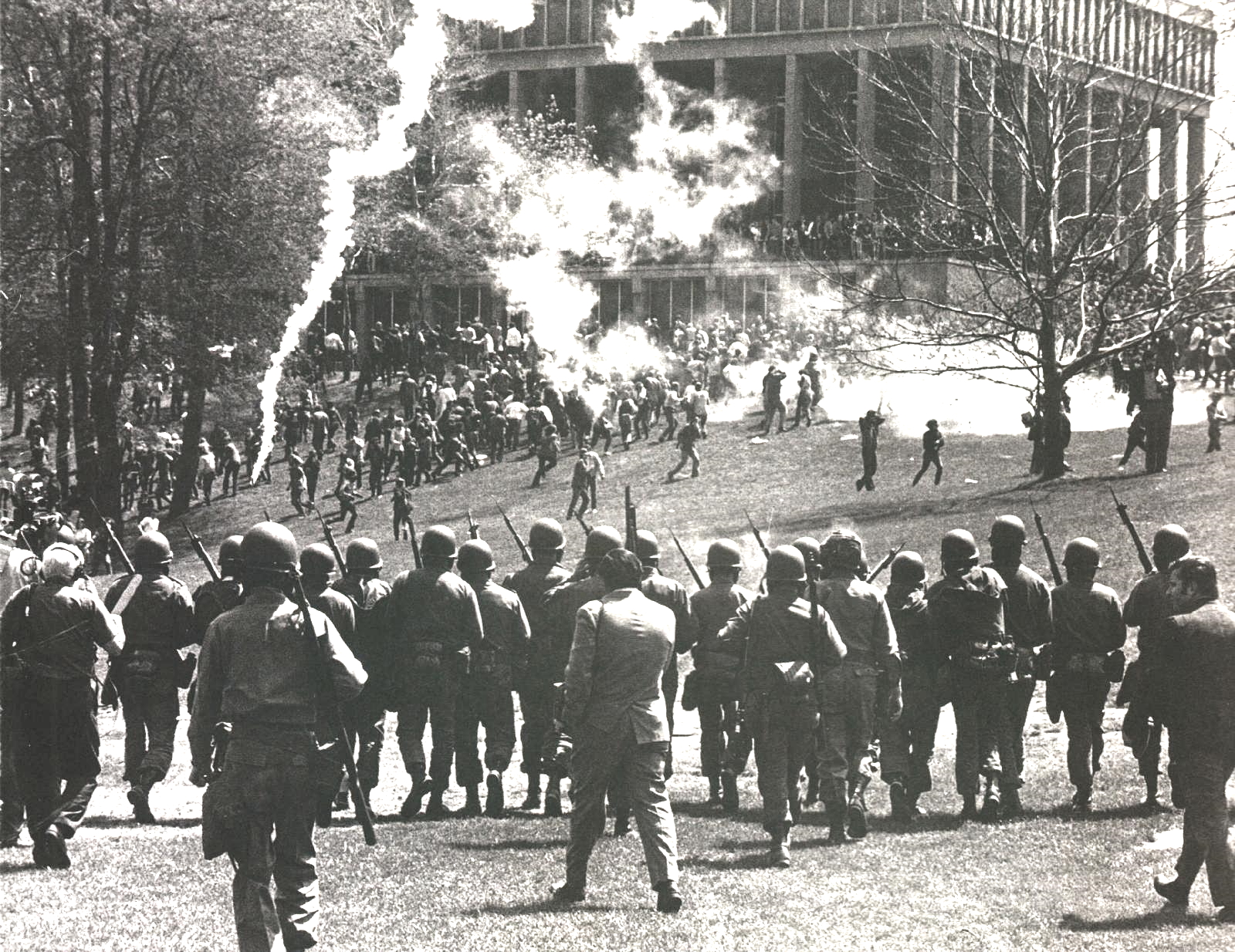
Ohio National Guardsmen at
Kent State University campus - May 4, 1970
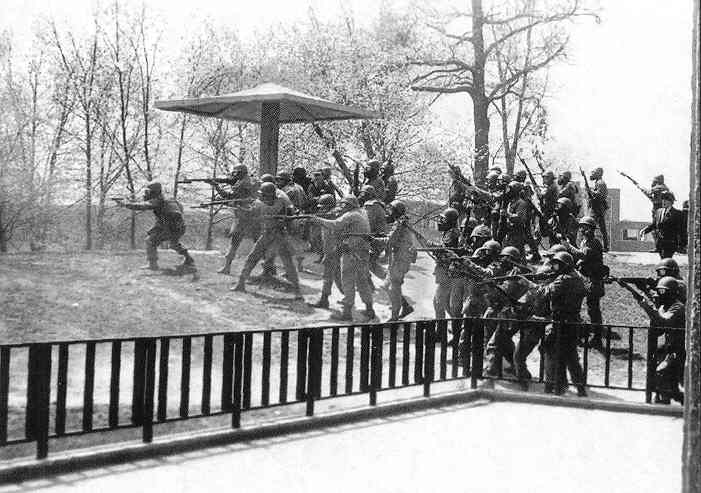
National Guardsmen firing
on students at Kent State University - May 4, 1970
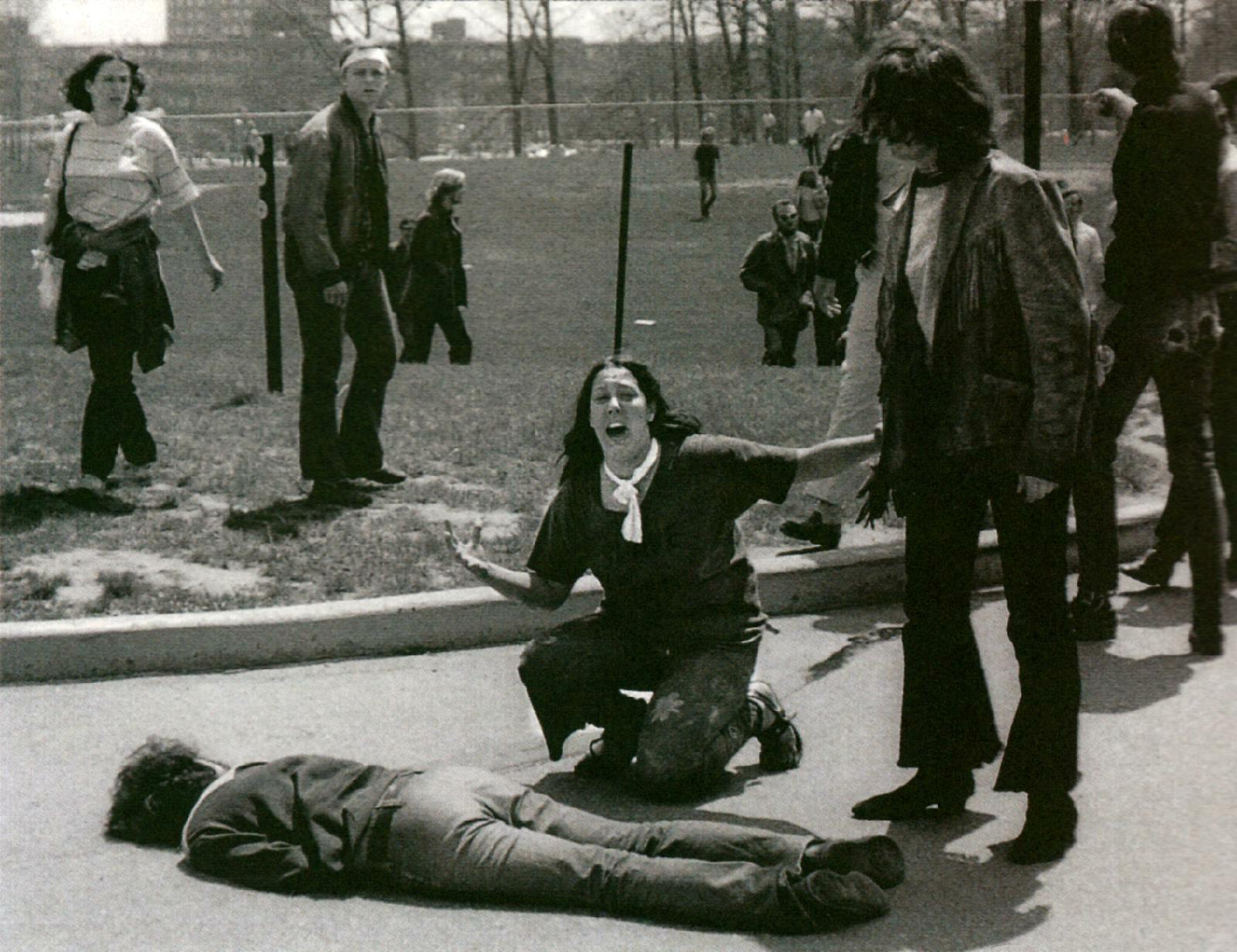
Jeffrey Miller killed at
Kent State - May 4, 1970
At the same time the Left-Right political divide deepens further
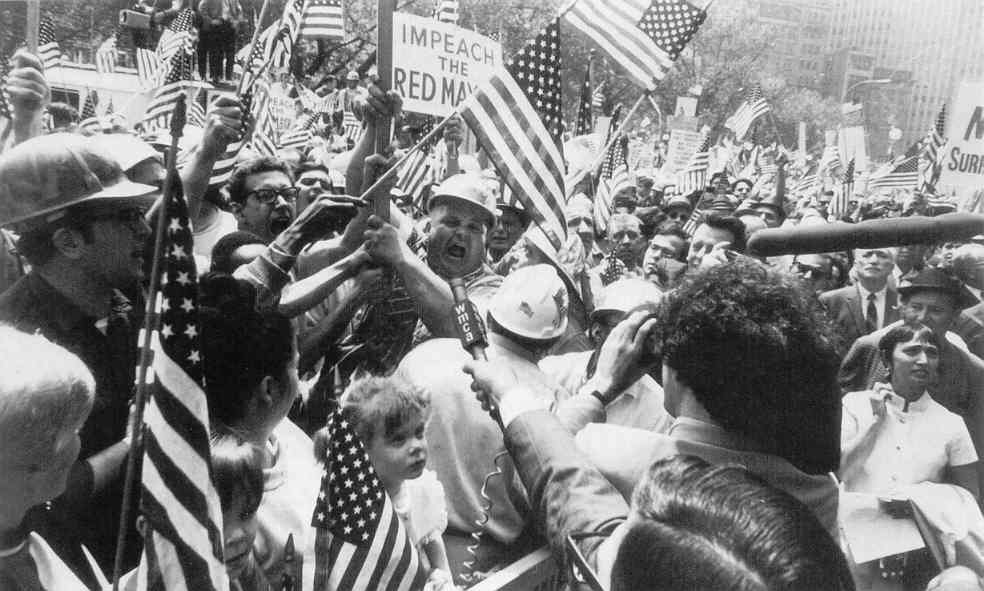
"Hard Hats" react to a Kent
State memorial demonstration in New York City
with a protest of their own - May 1970
VIETNAM VETERANS AGAINST THE WAR |
Despite
the fact that Nixon was pulling American troops out of Vietnam in a
quite orderly fashion, this seemed not to soften the anti-war mood of
young America. Thus in April of 1971 a protest against the war
(and Nixon’s refusal to simply quit Vietnam) led a huge number of
Vietnam veterans to gather in DC to demonstrate their opposition to
Nixon and his handling of the war.
At the same time, despite the fact that the Vietnam mess was a Johnson
byproduct, the Democratic Party was doing what it could to lay the
Vietnam issue at the feet of Nixon in the hopes of undercutting his
national popularity. Thus the rising moral voice of the
Democratic Party, "Chappaquiddick Ted" Kennedy, invited a young Army
Lieutenant, John Kerry, to Capitol Hill to testify before the Senate as
to the horrible things his fellow soldiers were doing in Vietnam.
He was very graphic about the atrocities that he had heard about (not
actually witnessed) – making him the hero of the hour … forming the
foundations for his own eventual rise in national politics alongside
Kennedy. Trashing fellow Americans – even America itself –
was now understood to be the correct way to demonstrate an individual’s
own "anti-fascist," thus saintly, moral character … a common feature of
"Liberal" American politics in those days (and largely since then) …
thanks to the rise of the Boomers – and the support and encouragement
of their political mentors (such as Kennedy). |
The anti-war protests continue ...despite Nixon's deep troop withdrawal. "Protest" has simply become an ingrained spirt among many Boomer Americans
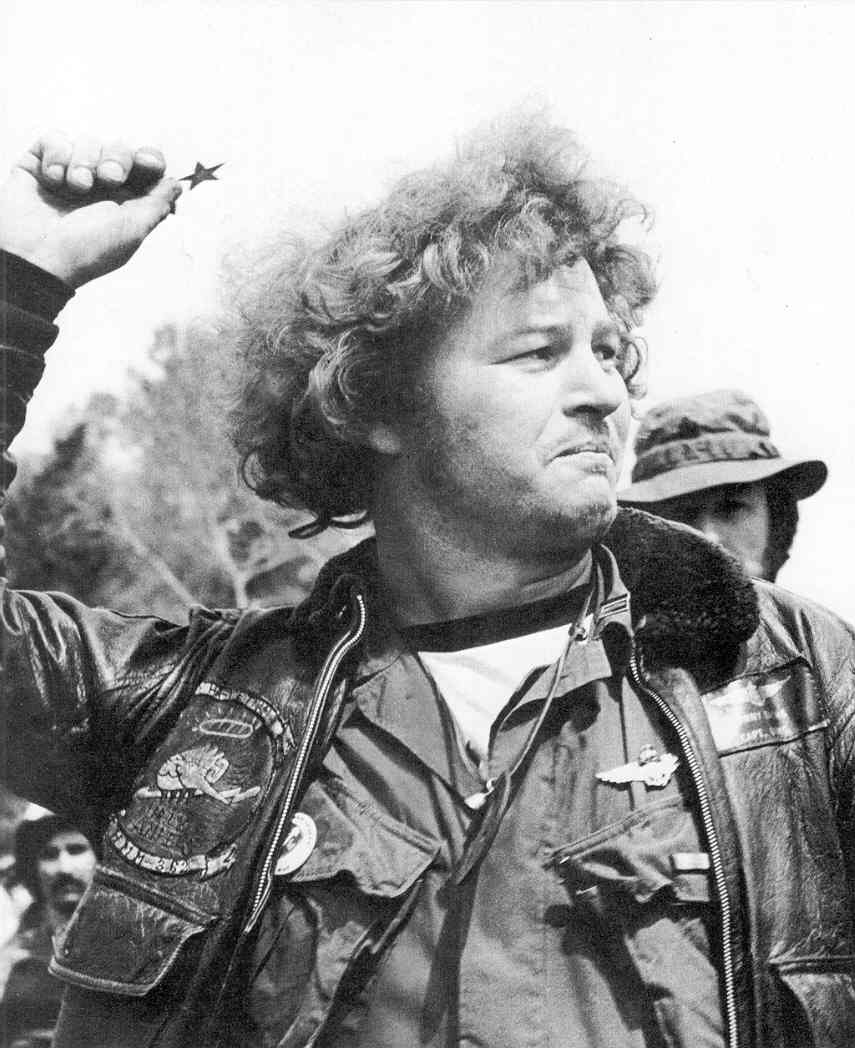
A Vietnam Vet tossing his
Bronze Star on the Capitol steps as the conclusion of Operation Dewey-Canyon III
- April 23, 1971

Vietnam Vets protesting the
war during the Operation Dewey-Canyon III

Sen. Ted Kennedy and John
Kerry on the Mall at Dewey Canyon III - April 21, 1971
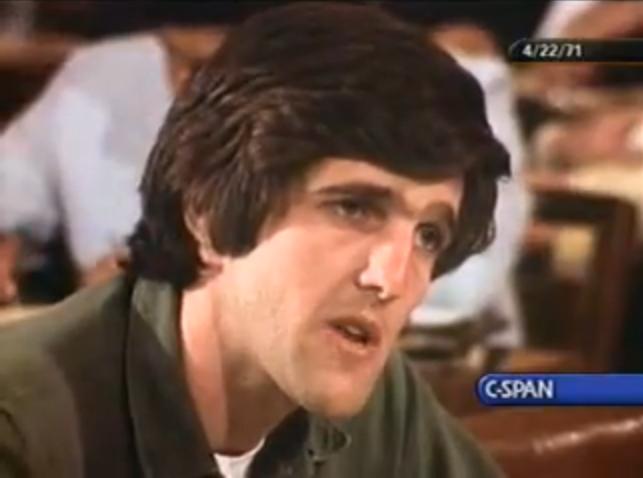
Vietnam
Vet Lt. John Kerry (future
Massachusetts
senator, Democratic Party presidential candidate and Secretary of State) testifying in the U.S. Senate
about all the war crimes reportedly committed in Vietnam by fellow U.S. soldiers (none of which he himself actually witnessed)
- April 21, 1971
Adding to this mood was the publication in June of 1971 by The New York Times of
secret documents that were part of a 1967 study commissioned by
Johnson’s Secretary of Defense, Robert McNamara, to give him details on
how the Vietnam War actually got up and running. What the Times
published, in what would come to be termed The Pentagon Papers,
was very unflattering of the Johnson Administration … and to some
extent the Kennedy Administration before him. Truly shocking was
Johnson's huge deception (not exactly unknown in DC) involved in
getting Americans onboard with his desire to make Vietnam a testimony
to his supposed diplomatic skills ... which sadly it did – for a while
anyway.
But what should have shocked Americans as much was how Democratic Party
politicians were able to transfer the blame for everything from Johnson
on to Nixon. Nixon actually had no part whatsoever in the startup of
the war – or anything else found in The Pentagon Papers!
But instead of letting blame fall on Johnson for the Vietnam disaster,
the lesson that the Democratic Party (and America’s Liberal press)
wanted Americans to come away with over all this was how dangerous it
was to trust any "imperialist" in the White House – and most
importantly, the imperialist occupying that position at that very time:
Nixon.
|
In June of 1971 the New York Times began front-page publication of the "Pentagon Papers" ... which is skillfully used to undercut the "Imperialist President " Nixon
... though he had nothing to do with any of the events covered by the report
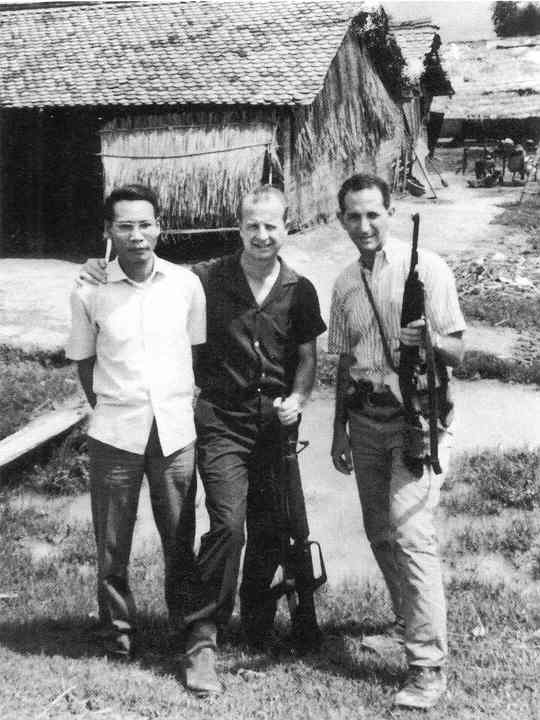
Daniel Ellsberg (right) and
John Vann (center) with Vietnamese village official - 1965. At this time a superhawk,
Ellsberg later reversed his position as he assembled policy papers for
McNamara – which he leaked to Neil
Sheehan of the New York Times
1972 - more young American
Vietnam-War Vets demonstrate against the continuation of American
support of the Saigon Government
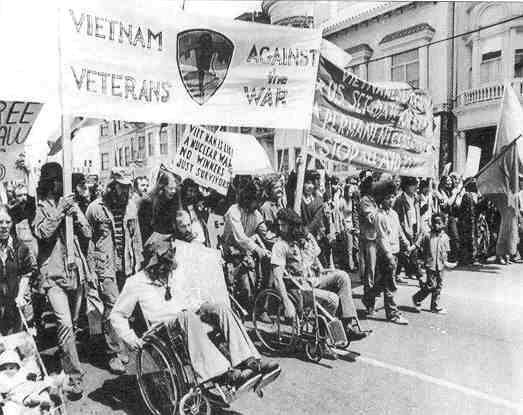
Vietnam Veterans in protest
against the War - San Francisco, 1972
... despite the fact that all US combat troops will be out of Vietnam in August of 1972
In mid-summer of 1972 America
is shocked to see a well-known American movie star, Jane Fonda, on her own "peacemaking"
mission to North Vietnam ... at about the same time
that America was attempting to force North Vietnam to agree to a peace that respected the existence
of the pro-West Saigon Government in South Vietnam. For multitudes of Americans
this made Fonda out to be a war-time traitor.
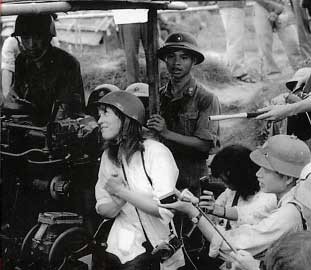 Actress "Hanoi Jane" Fonda
visiting North Vietnam Actress "Hanoi Jane" Fonda
visiting North Vietnam
and caught on camera with an anti-aircraft gun -
July 1972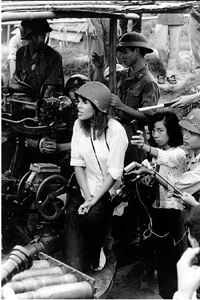
DETENTE WITH THE CHINESE AND SOVIETS |
Being the consummate practitioner of Realpolitik
(Political Realism) Nixon, along with his Secretary of State Henry
Kissinger, knew that they had to bring the major powers, Russia and
China, into the game so that the American withdrawal from Vietnam did
not turn into a Cold War catastrophe. Nixon had to make it worth
Russia and China’s while, because of America’s scheduled withdrawal
from Vietnam, not to slide into the picture as Vietnam’s liberators.
Following a testing of the waters with China in the sending of an
American table tennis team to China (April 1971), Nixon followed this
up by sending Kissinger on a secret mission to China (July), then
making a well-publicized visit with his wife to China in February of
the next year (1972) … where Nixon indicated that America was ready to
end its isolationist stance with respect to China (obvious at that
point) – even exchanging officials between themselves as something like
ambassadors.
Unlike Johnson, the political Realist Nixon did not see the Communist
world as a monolithic superpower bloc … but instead merely as an array
of nations who, most often, had only the label "Communist" identifying
them – and little else by way of mutual national interest holding them
together. Actually, Russia and China were very much competitors
in the international power game. Thus Nixon intended to utilize
their differences to strengthen the American position even more …
globally as well as in the Southeast Asian region.
Consequently, he and Kissinger then flew to Moscow in May of 1972 (only
three months after Nixon’s visit to China) to propose a stepping back
or détente in the nuclear
arms race, not only to ease East-West tensions, but to cut back on the
sheer expense of the arms race. Brezhnev was quite pleased to
receive the visit, plus the détente deal Nixon offered.
What he offered both Russia and China should have delighted the
American Leftists the way it shocked the Right Wing of his Republican
Party. Indeed, Americans in general tended to be highly favorable of
this development. But the Democrats were in no way willing to
acknowledge any kind of political success on Nixon’s part.
At the same time, he had to make it clear to the North Vietnamese that
he was deadly serious about his intent to keep South Vietnam from
falling to the Communist regime of Hanoi. Thus when, after Nixon
had reduced deeply America’s troop presence in the South, and when in
March of 1972 North Vietnam reacted by sending 120,000 of their troops
South, Nixon ordered a massive bombing of both Hanoi and its harbor at
Haiphong … cutting off supplies coming into the North Vietnamese
capital. This action, plus Nixon’s recent diplomatic advances with both
Russia and China, led China and Russia to lean heavily on North Vietnam
to slow up its movement South.
Thus, by that same spring of 1972, Nixon had reduced the American troop
presence in Vietnam to a mere 6,000 troops. This too
received no thanks from the anti-war Democrats
|
Nixon decides to send Henry
Kissinger on a secret trip to China
to probe the possibilities of improved
relations - July 9-11, 1971
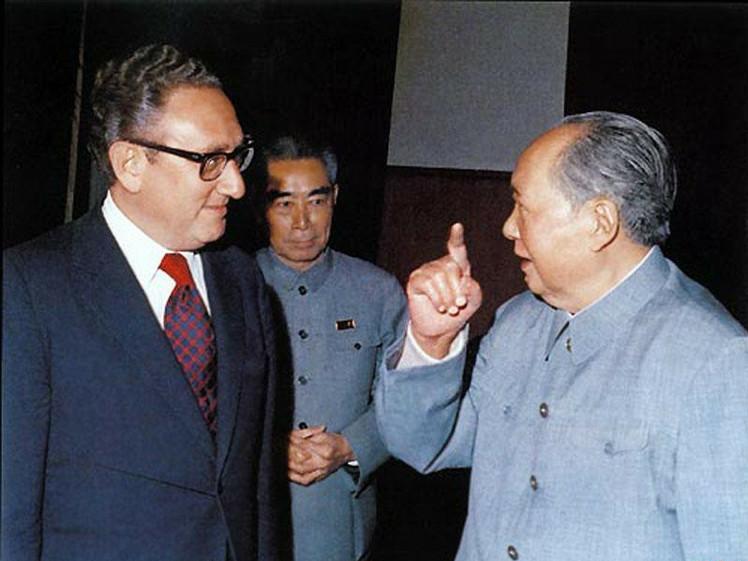
Mao Zedong, Zhou Enlai and
Henry Kissinger in China
With the way open, he and
Pat Nixon make the journey themselves the following
February (21-28, 1972) to mark an official shift
in American policy toward China
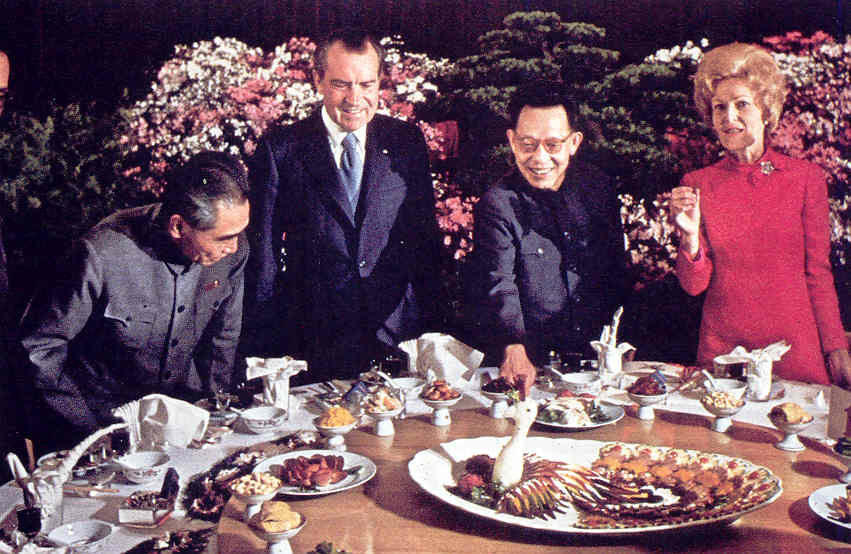
The Nixons visiting China's
Premier Zhou Enlai (Chou En-lai) [left]
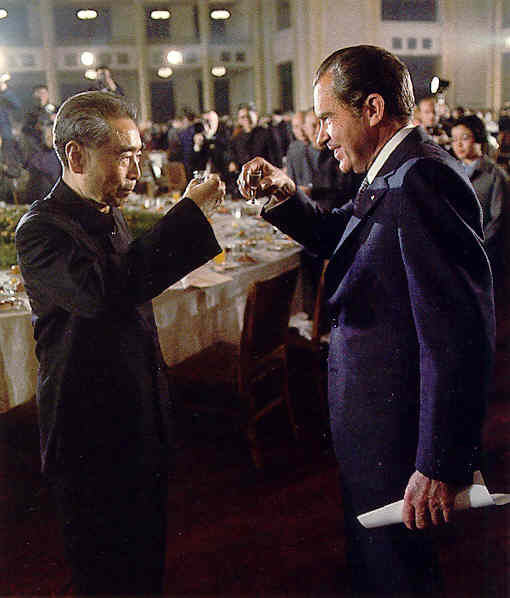
Nixon, the former Commie
hunter, now toasting Chou En-lai in Beijing - February 22, 1972
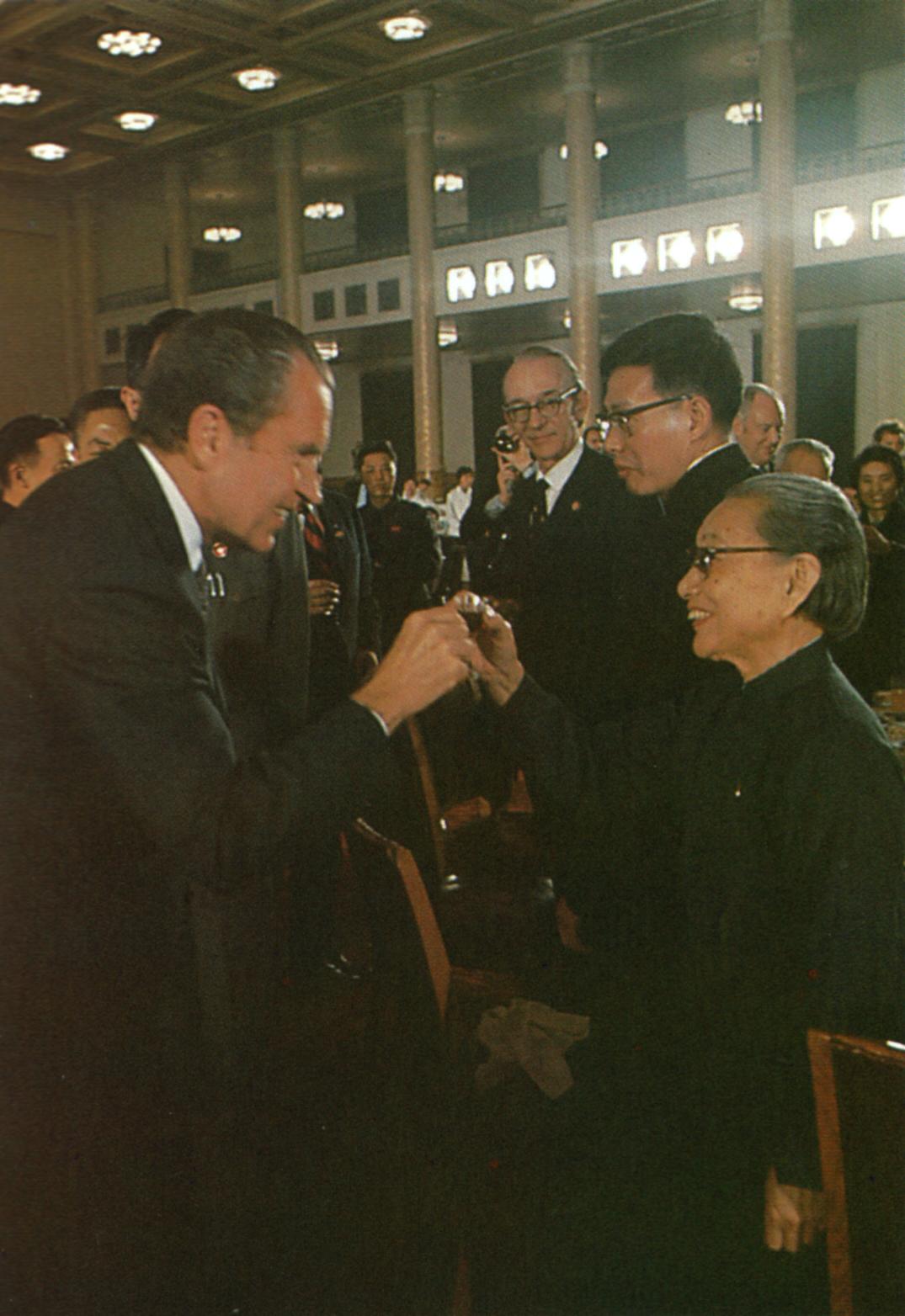
President Nixon toasts Deng
Yingchao, wife of Chinese Foreign Minister Chou En-lai in Beijing
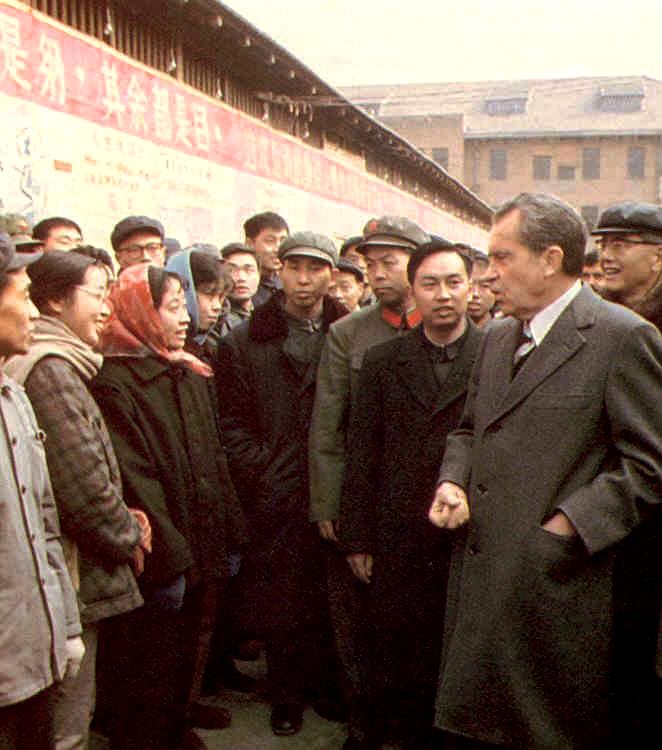 Nixon in China
Nixon in China
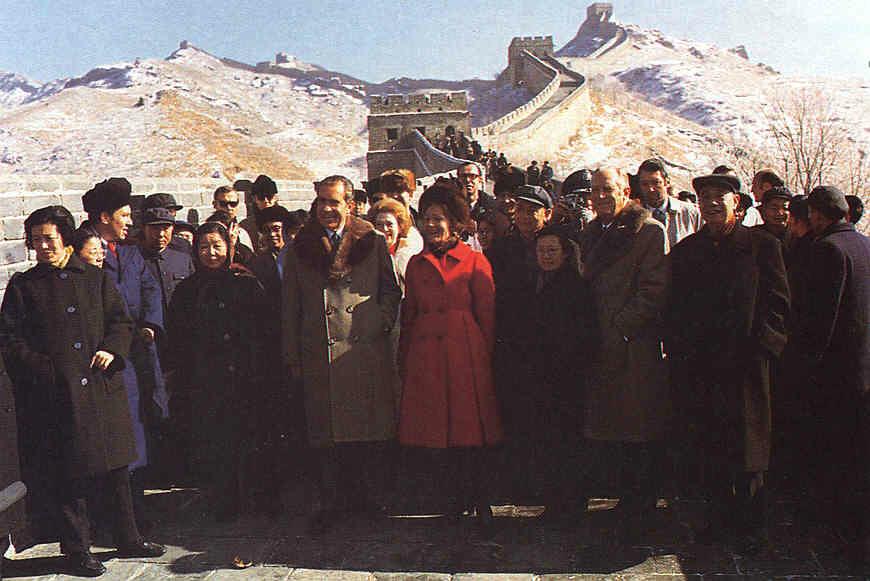 With Mrs. Nixon at the Great
Wall of
China
With Mrs. Nixon at the Great
Wall of
China
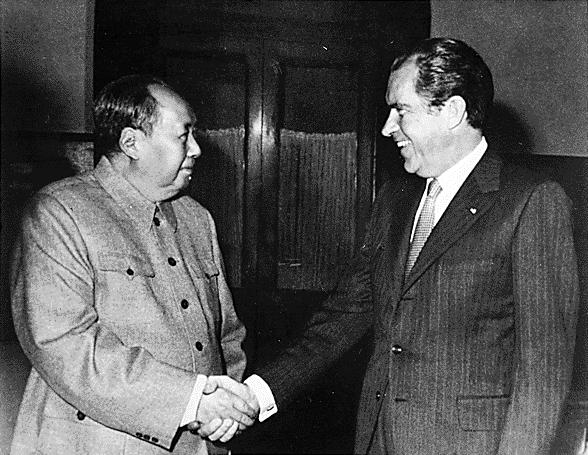
Nixon meets with
Mao Zedong in Beijing - February 1972
Then to "balance" these new relations, Nixon and Kissinger make a Moscow visit -
May 22-30, 1972
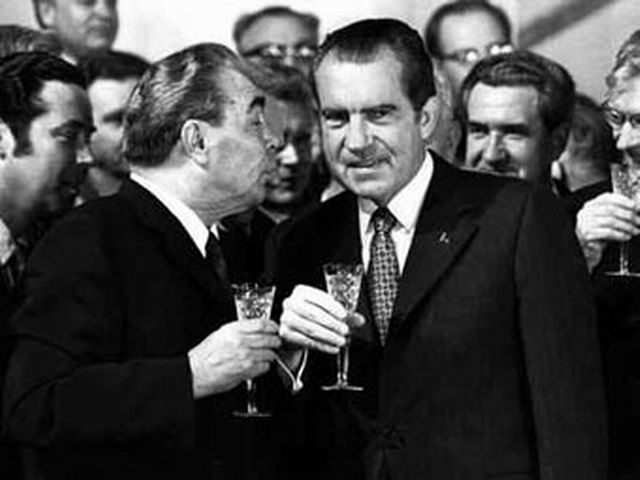
Nixon and Brezhnev during
Nixon’s visit to Moscow – May 22-30, 1972
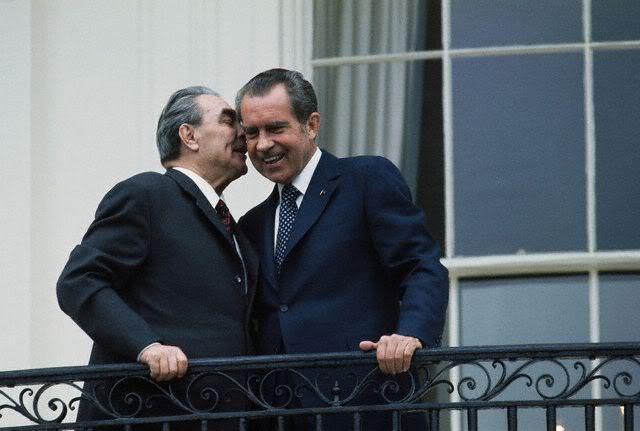 Nixon and Brezhnev during
Nixon’s visit to Moscow
Nixon and Brezhnev during
Nixon’s visit to Moscow
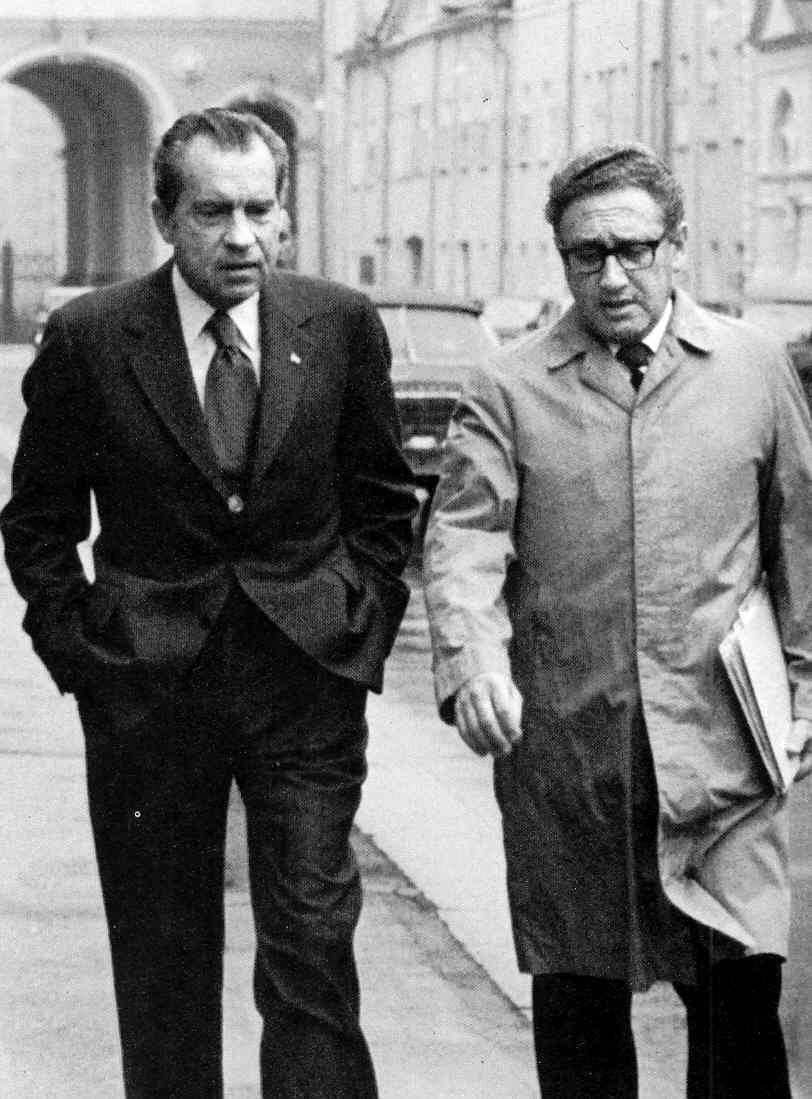
Nixon and Kissinger during
their visit to Moscow
When
in March of 1972 North Vietnam reacted by sending 120,000 of their
troops South, Nixon ordered a massive bombing of both Hanoi and its
harbor at Haiphong
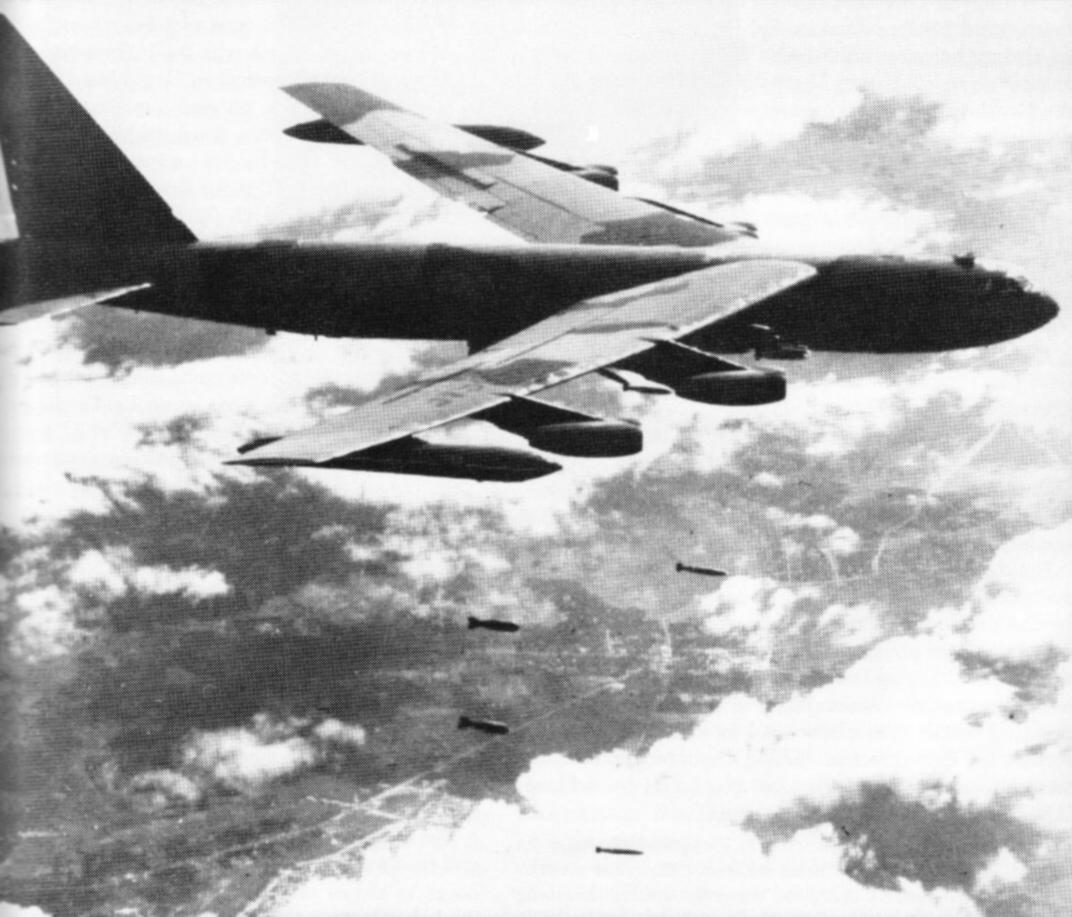
B-52 Stratofortress on bomb
run over North Vietnam
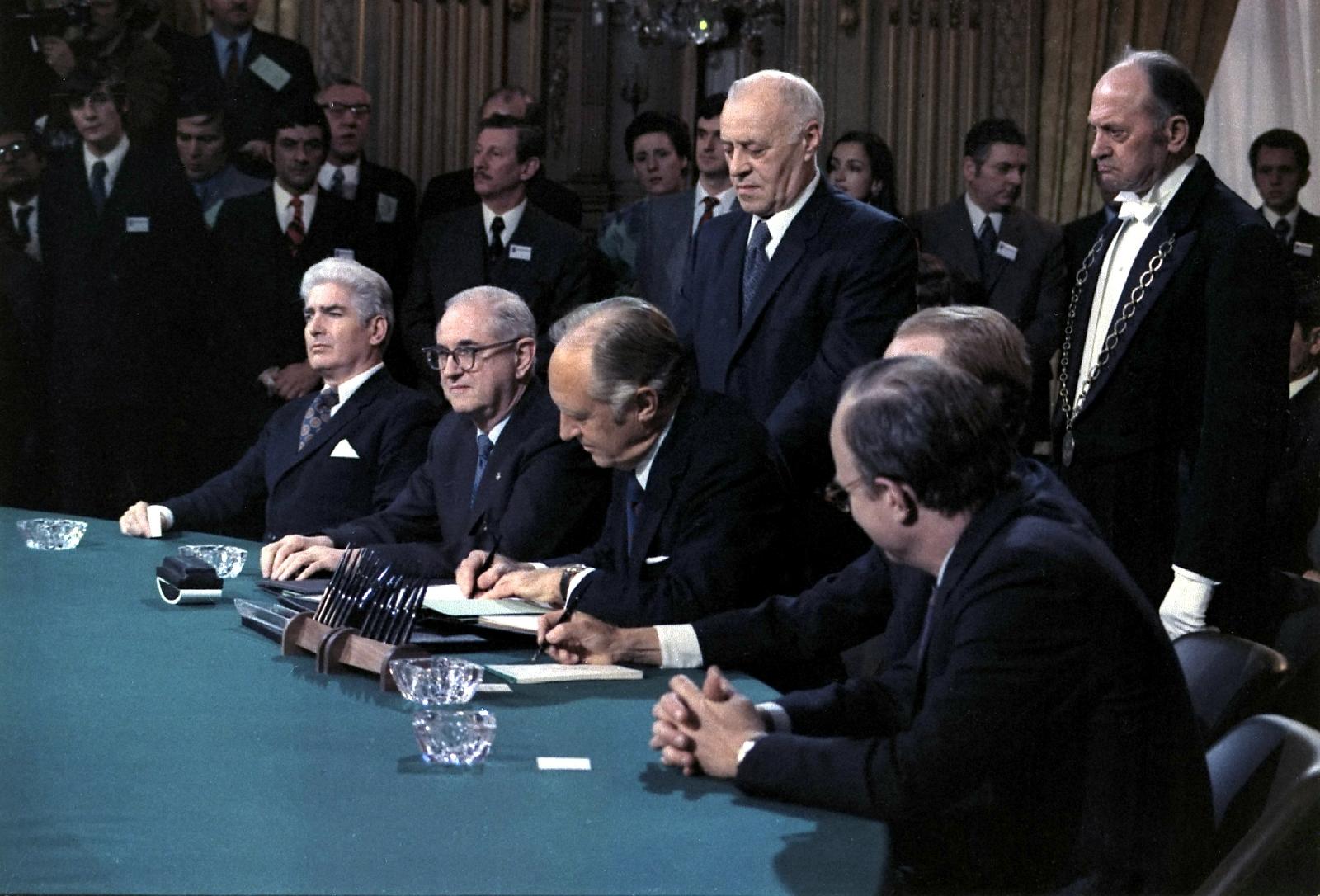
Vietnam peace agreement signing
- Paris, 27 January 1973
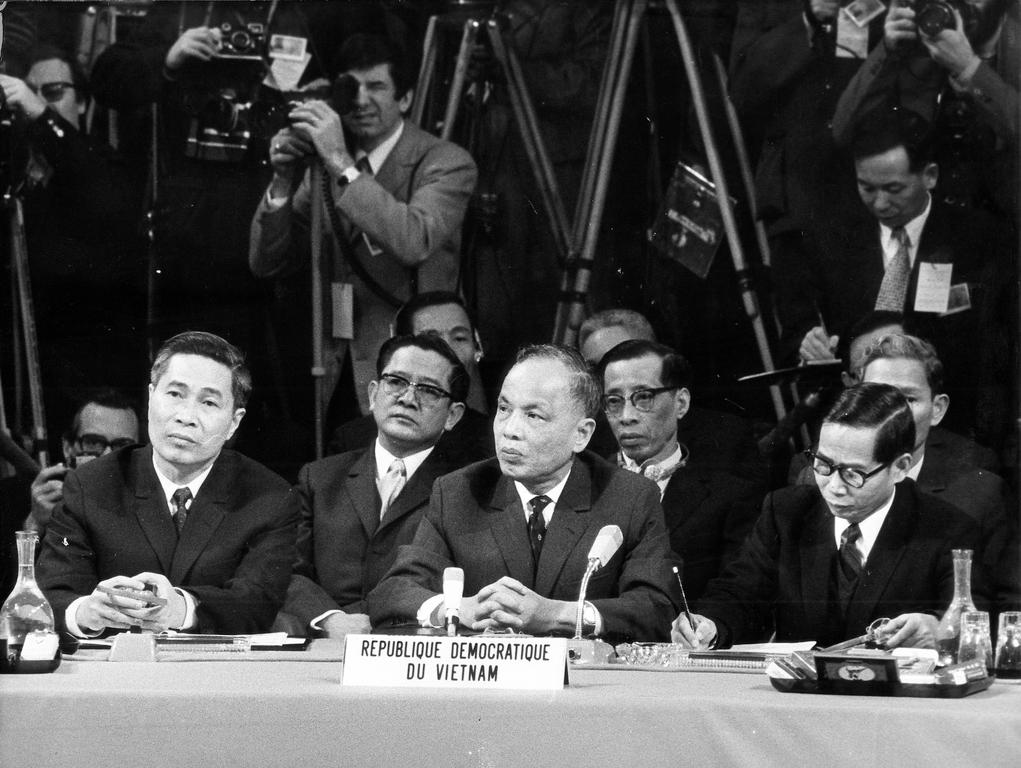
|
The 1972 American elections
But the American people themselves showed their gratitude that November
for the way Nixon brought the country out of the Vietnam mess – by
giving him a resounding victory in the November elections. Nixon
received 60.7% of the popular vote against his Democratic Party
opponent George McGovern’s mere 37.5%. And in the electoral
college, all except Massachusetts and DC2 voted for Nixon.
Yet at the same time in the Congressional side of the elections,
although the Republicans gained 12 seats in the House of
Representatives, the Democrats continued to hold on to their majority
(242 Democrats to 192 Republicans). And in the Senate, the
Democrats actually increased their majority (now 56 to 42) by acquiring
two additional senate seats.
Thus a strongly Republican President, facing a strongly Democrat
Congress, meant that America was not yet out of the political turmoil
that descended on it in the mid-1960s.
And very stupidly, members of Nixon’s reelection committee would give
the Democrats the opportunity to get rid of the President they hated so
much … when they were caught by police in attempting to break into
Democratic Party headquarters in the Watergate Apartment complex in
DC. These individuals were tried and convicted for their
crimes. But it was Nixon that the Democrats wanted to see behind
bars.
He was not accused of ordering the break in. But the assumption
was that certainly he would have done something (as would have any DC
politician) to "correct" the very embarrassing situation his staffers
created. So a Senate investigation committee was set up in
February of 1973 by the saintly Ted Kennedy3
to see what Congress could find that could incriminate the President …
which Nixon helped move along by firing special investigators appointed
to look into the matter.
As 1973 rolled along, tensions got so high over the Watergate event
that the well-publicized Congressional hearings replaced the afternoon
soap operas as what Americans preferred to watch.
Trying to conduct foreign policy during the Watergate era
As one last effort to convince both North and South Vietnam of Nixon’s
commitment to South Vietnam – and before a strongly Democratic
Congress, which made it clear that they wanted full abandonment of
Vietnam, was back in session – Nixon ordered the "Christmas bombing"
again of Hanoi and Haiphong. This time both North and South
Vietnamese representatives at the Paris talks finally signed the Paris
Peace Accords (January 1973).
But in June of 1973, with the Watergate hearings going full blast,
Congress felt itself fully empowered to pass the Case-Church Amendment
– which stated that at the end of a two-month period, the President
would no longer be allowed to provide any kind of military aid to
Vietnam!
In short, in taking over American foreign policy in Vietnam, Congress
undercut all the terms that had led to the Paris Peace Accord … and
left an open door for the North – still getting military aid from
Russia – to resume its assault on the South.
Congress strips the President of his discretionary spending powers
Nixon had promised the American people in his run for the presidency
that he would work hard to cut back on government spending. And
this he proceeded to do, impounding or refusing to release funds for
various spending programs put in place by the Democratic
Congress. This irritated congressmen badly (including many
Republicans) because they counted on being able to show local voters
how much federal spending that they were able to direct back to the
folks back home ("pork barreling"). And of course the powerful
Washington bureaucracy was strongly opposed to Nixon’s spending
cuts. Thus now with Nixon on the defensive, Congress went after
the president, enacting the 1974 Congressional Budget and Impoundment
Control Act. This prohibited the president from undertaking any
spending cuts without Congressional approval … eliminating presidential
budgetary powers that reached back to 1801, during Jefferson’s
presidency. And all this was done in the name of democratic
anti-imperialism.
To ensure that the president was put under strict surveillance on this
matter, Congress also set up the Congressional Budget Office … not
realizing they were also creating a government agency that would make
very clear to spending critics exactly how much political pork
barreling was actually going on in Congress. Oops!
2The
DC vote went 78% in favor of McGovern … not surprising because since
Johnson (and Roosevelt before him), the Democratic Party had come to
identify itself with the idea that the country would be best run not
from the Middle America "out there" in Georgia, or Kansas, or North
Dakota – but instead from Washington, DC … where supposedly America’s
real political brains were to be found! In the more recent
national elections, the Democratic Party vote in DC has topped
90%! You might wonder why there are any Republicans at all in DC!
3For various
reasons, however, it would be Sam Erwin, not Kennedy, who would chair
the Senate Committee doing the investigation. One explanation offered
was that having Kennedy head up this committee, a man who had high
hopes of being the Democratic Party's Presidential nominee in the 1976
national election, might make the investigation look partisan! An
unspoken explanation was that Kennedy's own moral credentials since the
Chappaquiddick incident were hardly admirable.
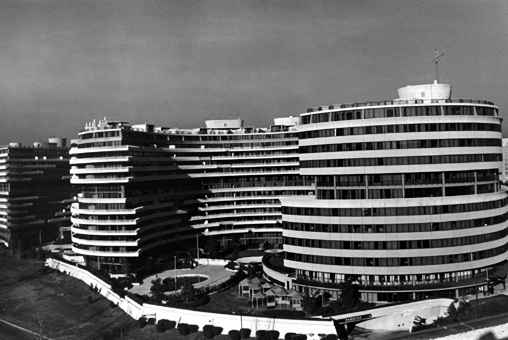
The Watergate
apartment complex –
Washington,
D.C.
where the Democratic national headquarters
were located
The Watergate burglars

James McCord
Virgilion Gonzales Frank
Sturgis Eugenio Martinez
Bernard Baker
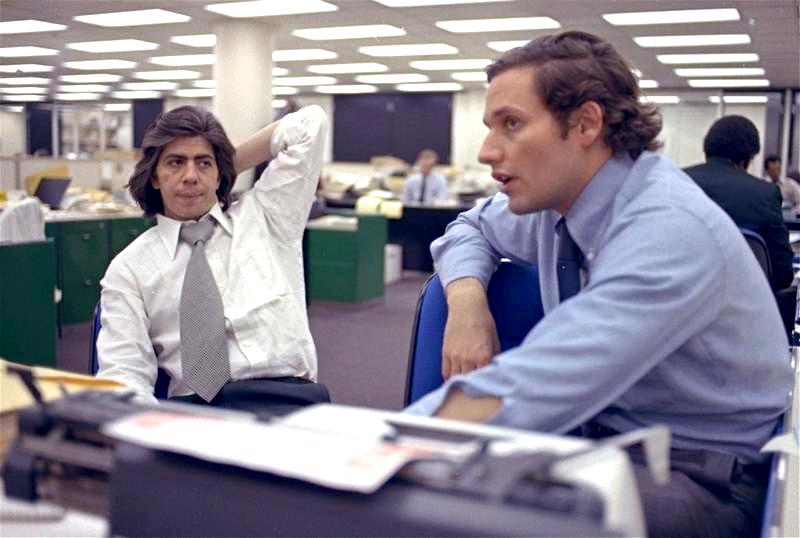
Washington Post reporters Carl Bernstein (left) and Bob Woodward
(right)
ANOTHER ARAB-ISRAELI WAR (OCTOBER 1973) |
While
all of this anti-imperialist democracy was going on in America,
tensions had been building in the Middle East between Israel and its
Arab neighbors. Nothing had changed for the Arabs since the 1967
catastrophe … including Arab anger over the postwar situation.
Israel still controlled the Sinai Desert all the way up to the Suez
Canal and West-Bank Palestine remained in Israeli hands – as well as
Syria’s Golan Heights.
In the meanwhile, Nasser had died in 1970, and was replaced by Anwar
Sadat, who approached his Egyptian presidential duties not from the
showy political stage that Nasser liked to play on, but quietly from
his own version of Realpolitik. By 1972, he was cleverly putting
together a plan that would indeed catch Israel off guard … and, at
least for a bit, throw Israel into retreat in the effort to regain lost
Egyptian territory.
Egypt had long been gaining military support from Russia, helping
enormously to modernize the Egyptian military … although with the
American détente, the Soviets were losing interest in this expensive
involvement with Egypt. But in any case, without any warning or
explanation, in July of 1972 Sadat simply ordered the 20,000 Russian
advisors out of Egypt. He then, over the summer of 1973, began to
conduct extensive military exercises – ones that always put Israel on
alert … although nothing further came from any of these episodes.
At the same time Sadat had been sending out diplomatic missions to see
if he could get some international help in getting the situation (as
actually called for by a U.N. resolution ... though ignored by Israel)
back to some kind of benefit to the Arab world. And secretly, he
had been working with Syria’s President Hafiz al-Assad and with the
Arab-dominated oil cartel (OPEC) to get them to agree to cooperate in
case of some kind of Egyptian action against Israel.
Then on October 6th of 1973, another of these exercises turned into the
real thing … when Sadat’s troops crossed the Suez Canal and charged
into the Sinai Desert, this time well protected by extensive Egyptian
air power. Although this was timed to coincide with the Jewish
holiday of Yom Kippur, in which the Israelis were supposedly focused
elsewhere, the Israelis actually were not unprepared for the event. In
fact some of the Israeli officers suspected something was afoot and
wanted to strike first. But Israeli Prime Minister Golda Meir was
adamant that the Israelis must not strike first, lest it cause them to
lose the sympathy and support of the West, especially in America.
But the Egyptian attack proved to be much bigger and more effective
than the Israelis had anticipated … with the Egyptian army and air
corps, aided by Surface-to-Air missiles (SAMs), quite able to match up
with the Israeli equivalent. Both ground and air combat was
therefore proving highly destructive to both sides.
At first the only field that Israel was able to move to its own
advantage was against Syria in the Golan Heights. This they
regained … then headed to Damascus, the Syrian capital. But the
intervention of Iraqi troops blocked that move.
And as each side ran out of guns, tanks, and planes, the conflict
eventually turned onto a matter of resupply, Egypt getting new supplies
from Russia as of the 9th of October, and Nixon and Kissinger directing
American supplies to Israel … though with some of America's European
allies refusing to cooperate in this move, delaying the American
delivery until the 14th of October.
But when on the 19th of October Nixon asked Congress for $2.2 billion
in aid for Israel, OPEC swung into action … cutting back oil production
and blocking all oil sales to America, Portugal, and the Netherlands
(the European countries allowing America to use its airspace to run
supplies to Israel).
Russia and America finally got the U.N. to come up with a ceasefire
proposal on the 22nd of October. But with things on the ground
finally going Israel’s way, Israel ignored the ceasefire and even
crossed the Suez Canal in order to surround an exhausted Egyptian
army. Only when the Soviets threatened to intervene directly did
the action come to something of a standstill (October 28th).
In the meantime, with OPEC production cut back even further, oil prices
skyrocketed from $3 to over $11 per 42-gallon barrel. A huge
international energy crisis thus exploded. Nixon tried to meet
the challenge by opening American oil reserves – and reducing the speed
limit on America’s highways to 55 miles an hour – although this
ultimately did little to address the energy crisis.
At the same time, OPEC members4
now found themselves to be fantastically rich – creating a new
political dynamic … one which the Saudis handled wisely by making sure
that the new wealth was distributed widely among its population.
But in the Shah’s Iran, that wealth went largely to a few wealthy
families … bypassing the huge peasant population that was facing an
enormous jump in the price of energy and fertilizer – with
international food prices not moving up with those costs (American food
production kept those prices fairly steady). The new
dynamic was therefore making multitudes of Iranians actually poorer –
much poorer. This would quickly translate into a huge political
problem for the Shah … one he seemed to not know how to address.
4Neither Egypt or Syria were oil producers, and therefore suffered from the rise in oil prices … like the non-Arab world!
The "Yom Kippur War" – October
6 to 26, 1973
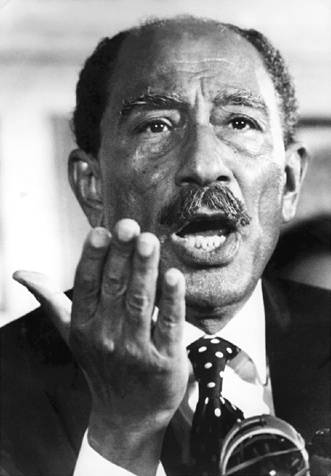
Egyptian President Anwar
as-Sadat
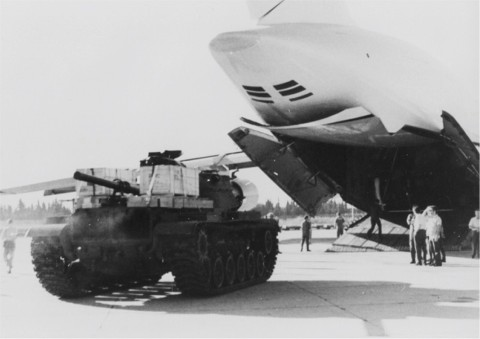
A C-5 Galaxy unloads an M-60
Patton tank at Ben Gurion International Airport
during Operation Nickel
Grass
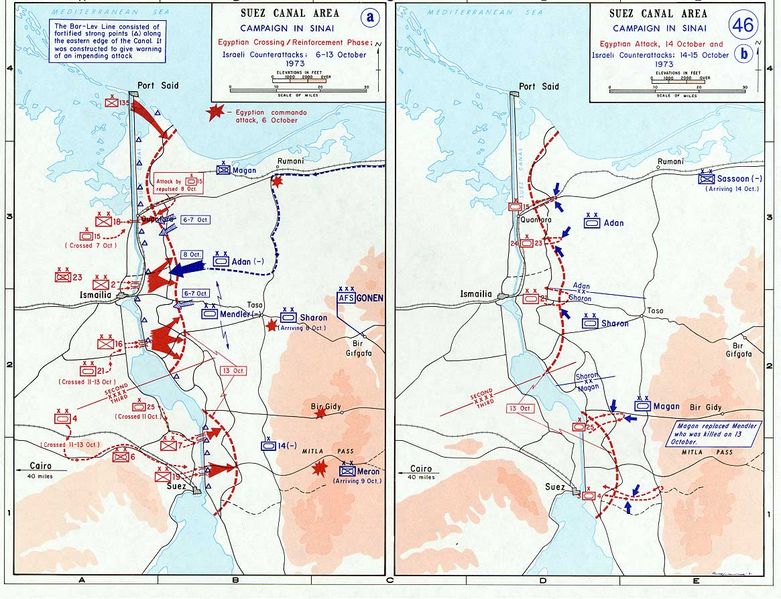 The 1973 War in the Sinai,
October 6-15
The 1973 War in the Sinai,
October 6-15
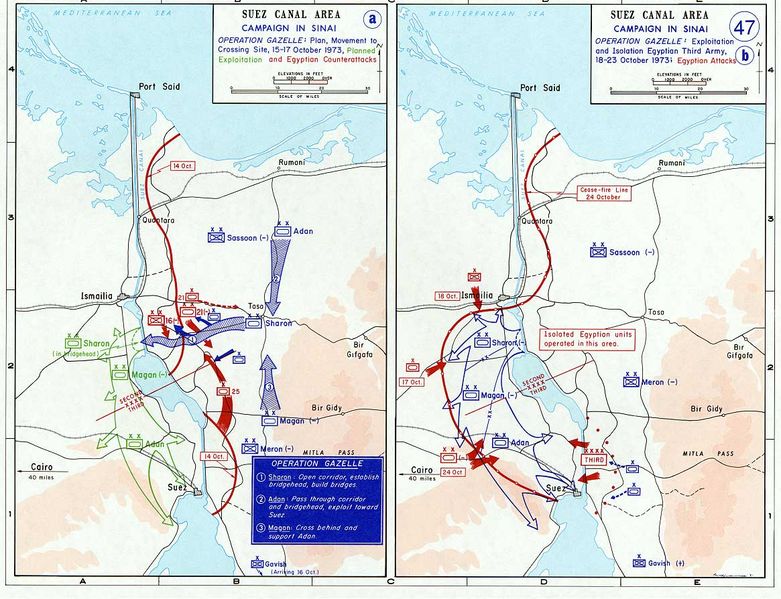 The 1973 War in the Sinai,
October 15-24
The 1973 War in the Sinai,
October 15-24
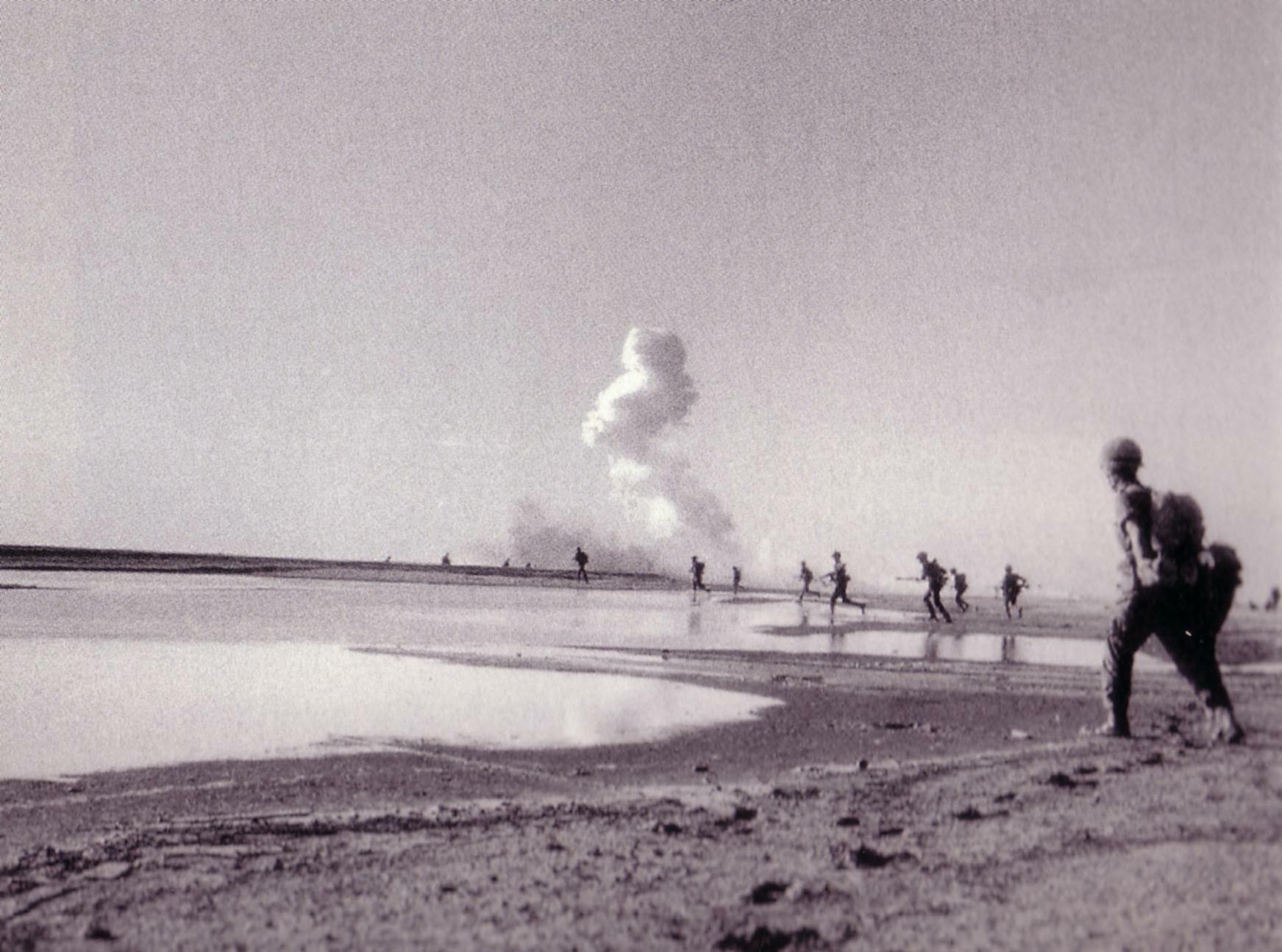
Yom Kippur War - October
1973. Israeli paratroops breaking through an
Egyptian commando ambush in a sandspit leading to Fort Budapest
on the Sinai front
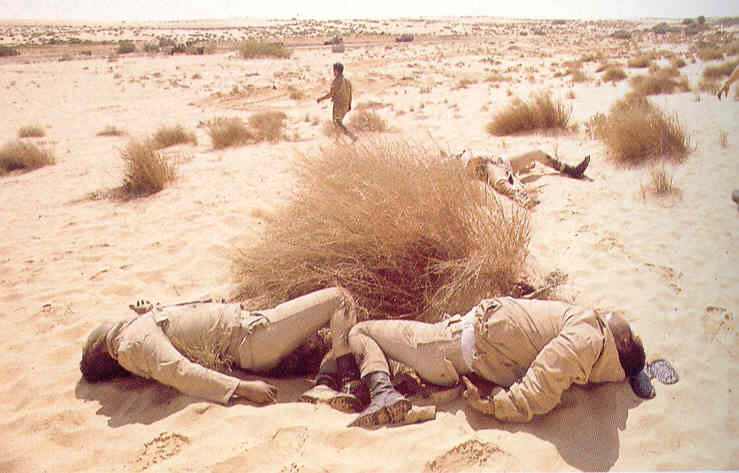
Egyptian soldiers killed
during the October or Yom Kippur War – 1973
 Yom Kippur War - Syrian
Theater
Yom Kippur War - Syrian
Theater
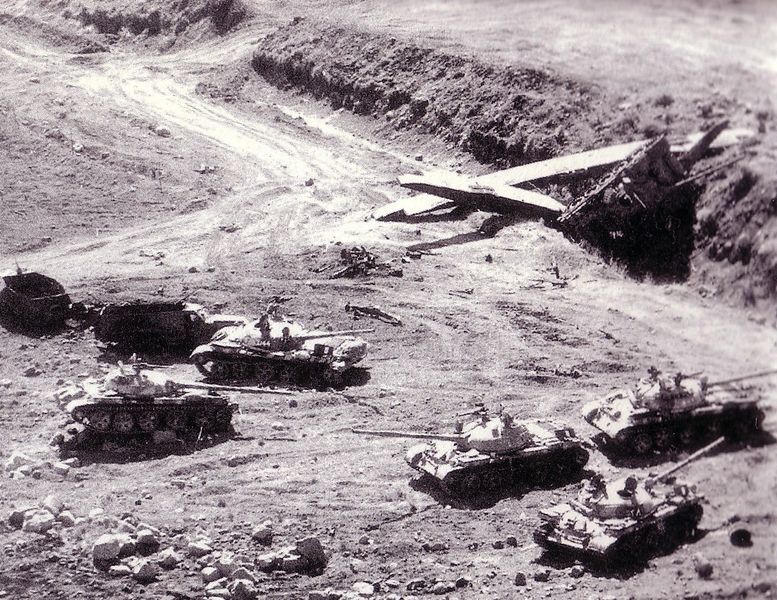
"Syrian tanks at Israeli
anti-tank ditch in the Golan. A tank, hit by Israeli fire, has fallen off
one
of the two bridges the Syrian laid across the ditch. Another knocked
out tank lies in the ditch.
To the left is the roadway the Syrians later
succeeded in opening through the barrier."

King Khalid overlooking a
model of a $8.5 billion military city,
to be paid for with increased oil
revenues – mid-1970s.
CONGRESS BRINGS DOWN NIXON – AND VIETNAM ... AND BRINGS FORD TO THE PRESIDENCY |
|
Congress cuts off all support of South Vietnam
By early 1974, the energy crisis shaking the world also hit South
Vietnam hard, the government unable to pay for fuel for its
military. In May, Nixon asked Congress for supplemental funds to
help Vietnam to get through the remaining time until it was up for
renewed support under the new fiscal year only a month away (the end of
June). But not only did Congress refuse this request, it also
announced that America would be ending all further financial support of
South Vietnam as of the end of 1976!
What in essence Congress was doing was inviting Russian-supported North
Vietnam to undo whatever progress America – under Johnson – had
undertaken to achieve, at the cost of hundreds of thousands of lives,
both American and Vietnamese. This was to be a key move of
Liberal America in its effort to end America's "imperialist" program …
especially the part under the Nixon presidency.
But Nixon was the one who had brought the boys home … and had offered
in its place economic support (plus air action if North Vietnam
violated the Peace Accords). And since when did economic support
to a struggling ally constitute imperialism? America had been
doing this very effectively since the days of the Marshall Plan.
But political rhetoric rather than well-thought-through foreign policy
was what this was all about. Politics was becoming a media event,
not a well-planned and wisely-led government program.
Nixon's resignation, and Ford's assumption of the Presidency
By early August of 1974, it was quite clear that a
Democratic-Party-controlled House of Representatives was ready to
impeach Nixon. And although the Senate would require a
2/3rds majority to convict, the Republicans – many going into elections
that fall – were certain that any Congressional action was likely to
hurt the Republicans deeply. Thus they pleaded with Nixon to
resign. He agreed to do this.
Consequently on August 8th, Nixon appeared before the press to announce
his resignation – and then flew off … to leave the presidency in the
hands of his Vice President Gerald Ford.
But Gerald Ford was well liked on Capitol Hill. After all, it was
Congress, not the American people, that elected him to the
vice-presidency … when criminal charges were brought to Nixon’s
original vice president, Spiro Agnew, and Agnew was thus forced to
resign.
But there were two problems that came with the Ford presidency.
Congress, because it voted him into power, believed that it owned
him. And secondly, Ford was a man of deep Christian
integrity. He knew that the political Left was not finished in
what it intended to do to Nixon now that he was a private citizen and
subject to prison time. Thus Ford, after much prayer on the
matter, came to the decision to issue Nixon a presidential pardon …
knowing the fury this would stir on the American Left. But
America had other business it needed to attend to. And it was
time to stop this attempt to lynch an American president.5
5The
American Left, which "forgave" (actually merely ignored) Ted Kennedy
over the death of a young lady in his company, would never let up on
Nixon – making sure that the history taught in American schools and
universities would always present Nixon as the "evil president."
Actually, Nixon would recover stature privately, and would be sought
quietly by future presidents and public officials for his wise counsel.
Nixon resigns the
Presidency - August
9, 1974
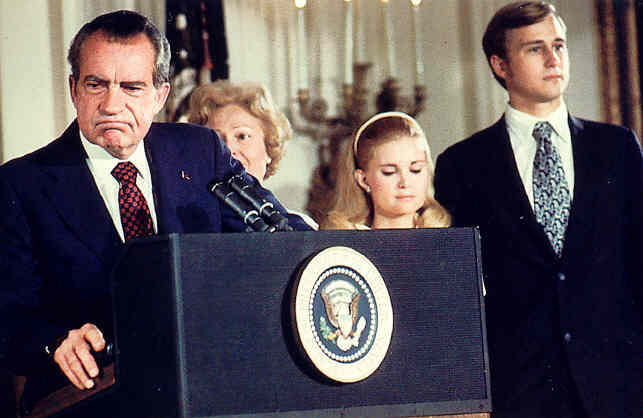
Richard Nixon announces his
resignation – August 9, 1974
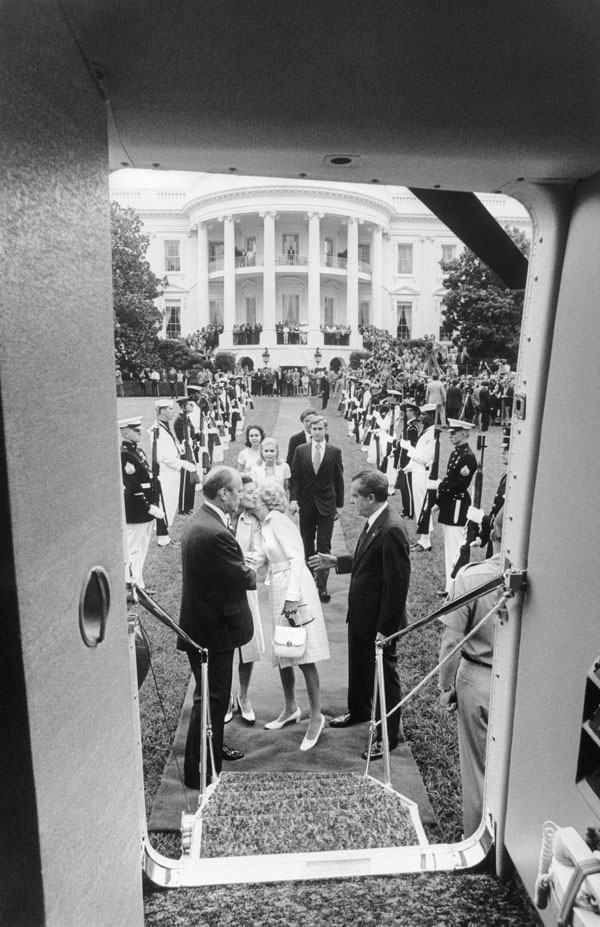
Richard Nixon departs from
the White House before Gerald Ford was sworn in as President
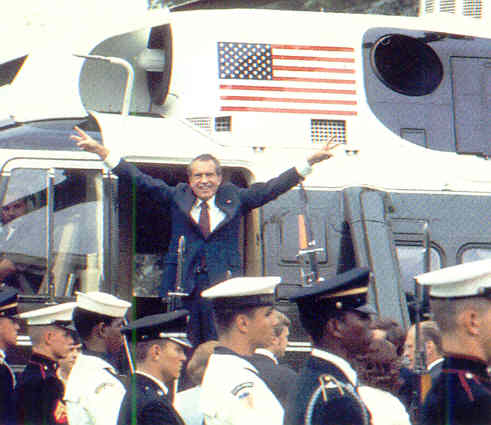 Nixon bids
good-bye
Nixon bids
good-bye
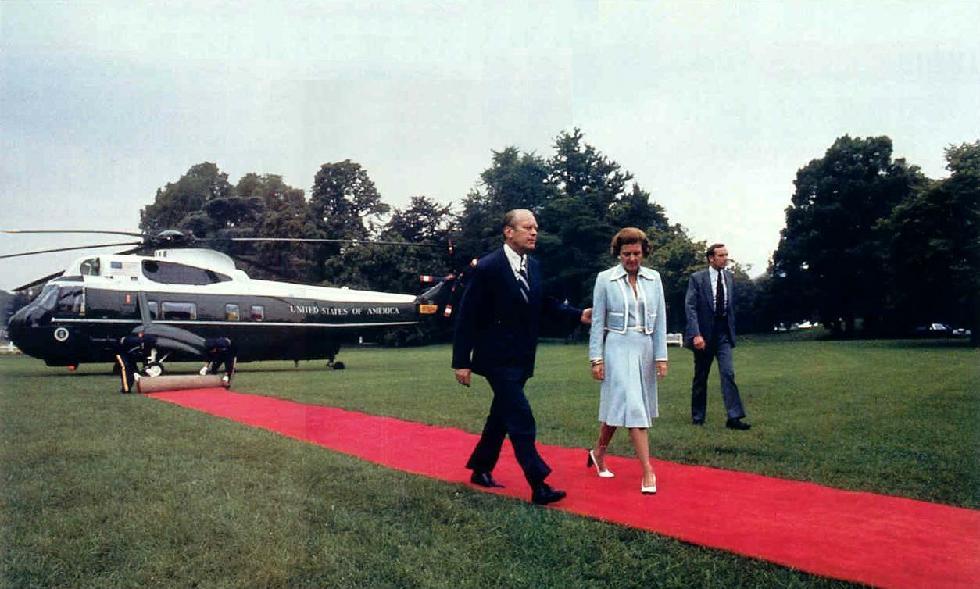
Ford's first steps toward
his new duties as President – August 9, 1974
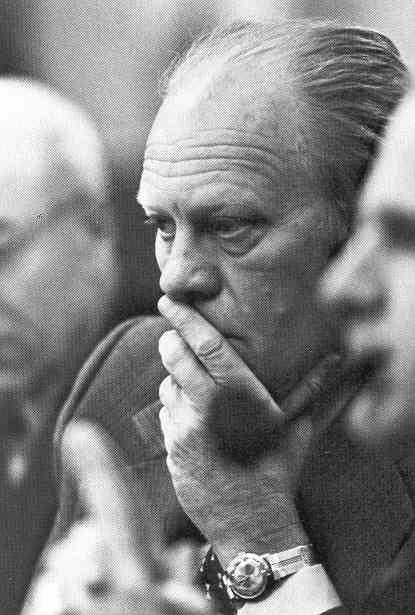 Gerald R. Ford - President
1974-1977
Gerald R. Ford - President
1974-1977
Ford attempts to carry
forward Nixon's high diplomatic
legacy abroad
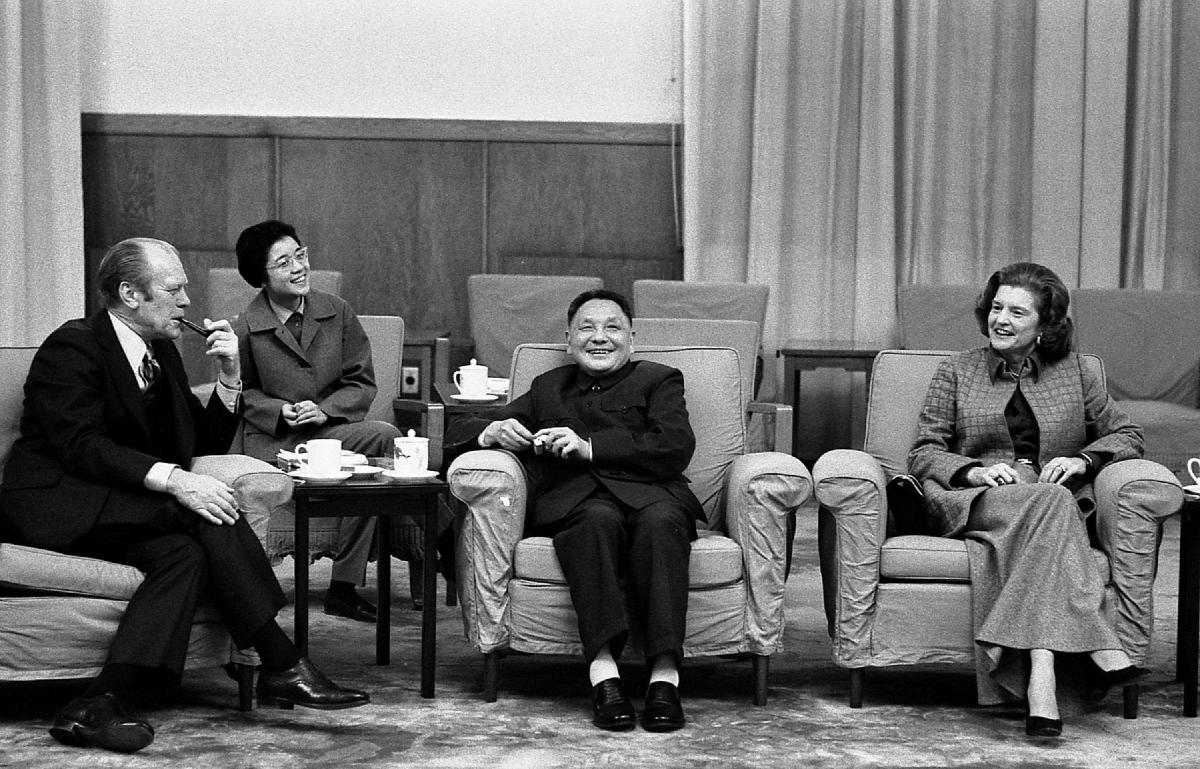
President and Mrs. Ford,
Vice Premier Deng Xiao Ping, and Deng’s interpreter have a cordial chat during
an informal meeting in Beijing, China - 1975
But
the Liberal Left was not in a mood to
see Nixon's legacy survive under any terms ... no matter what it would cost not only
America but even the larger world. That cost will eventually run high ... very
high.
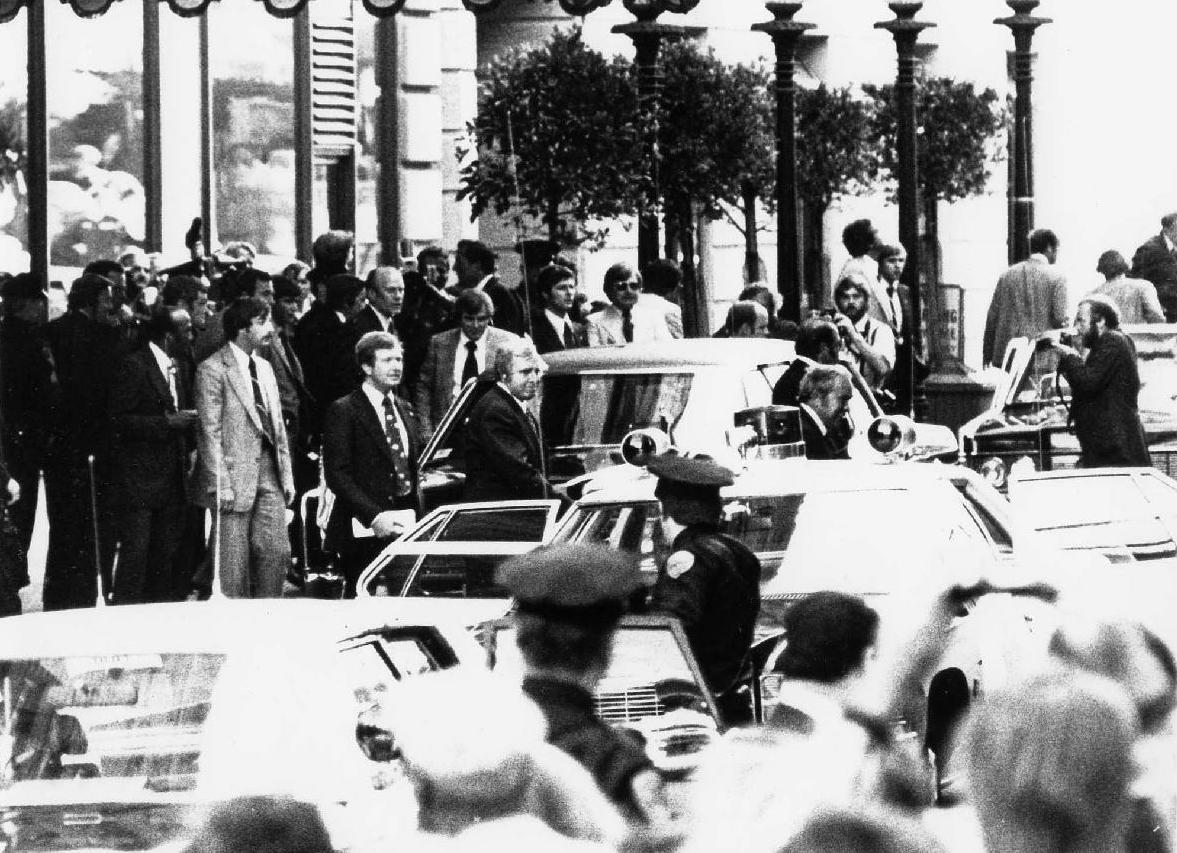
Reaction of Secret Service
agents, police, and bystanders approximately one second after the (2nd) assassination
attempt on President Ford -- this time by Sara Jane More, September 22, 1975.
THE HORRIBLE AFTERMATH OF CONGRESS'S "ANTI-IMPERIALISM" IN INDOCHINA |
Tragically,
it became quite apparent that the South Vietnamese government was not
going to be able to stand up to the offensive orchestrated by the
Soviet-supported North Vietnamese government when Congress announced
its ending of all support of the South. Step by step the North
advanced against the South … until it was on the edge of full defeat
(losing some 80,000 soldiers killed in the process). At this
point (the end of April 1975) the decision was made to pull out all
American personnel remaining in the South … with terrorized Vietnamese
trying to find a way themselves to make just such an escape.
The pictures of Americans fending off desperate Vietnamese as Americans
made their own escape was truly humiliating. But there was
nothing that the Ford Administration could do about a situation that
was now directed from a "democratic" Congress … and not the
presidential office.
But the horror did not stop there. A huge number (perhaps a million)
Vietnamese were carted off to Communist "re-education" camps … where
they suffered terribly, many dying in the process. Also South
Vietnamese farms were "collectivized" Stalinist and Maoist style, which
of course crippled the economy and brought on mass hunger.
|
Without American support, the social-political system of South Vietnam quickly dissolves
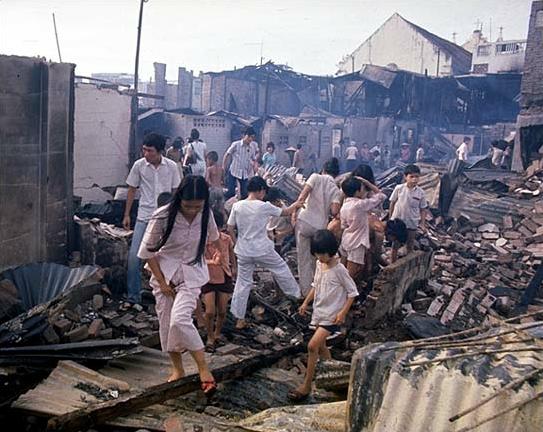
Vietnamese searching for
survivors of a North Vietnamese rocket attack on Saigon
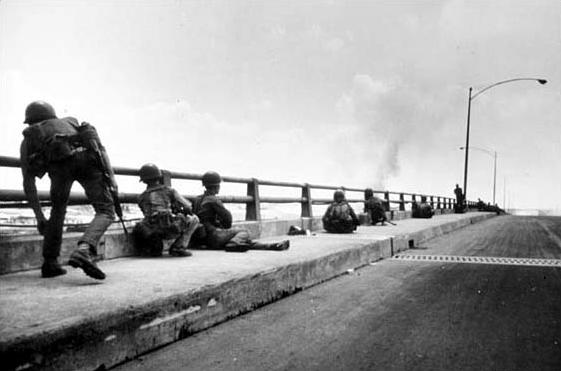
South Vietnamese troops'
last stand before Saigon
And a now-helpless America is forced simply to abandon the country to its new Communist masters
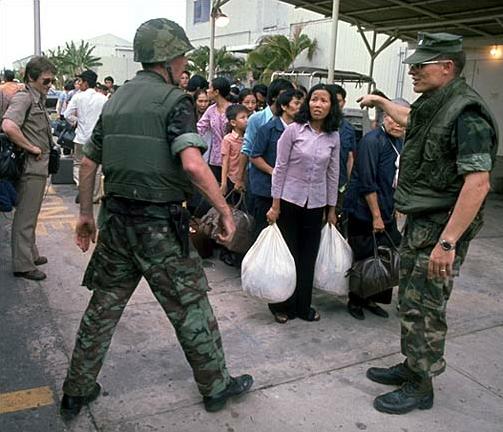
South Vietnamese seeking
escape out of Vietnam with American servicemen
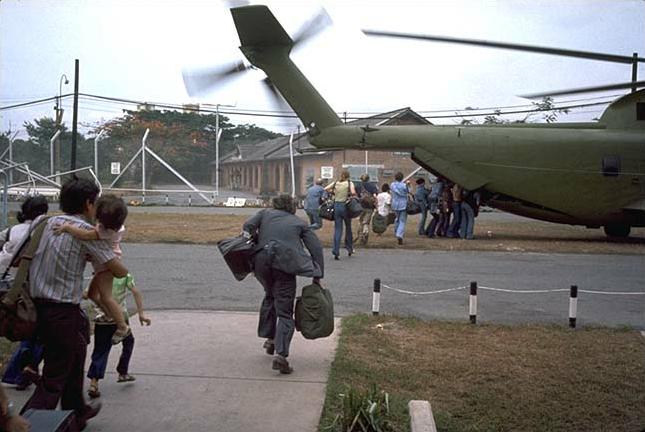
South Vietnamese and Americans
head for the helicopters out of Saigon
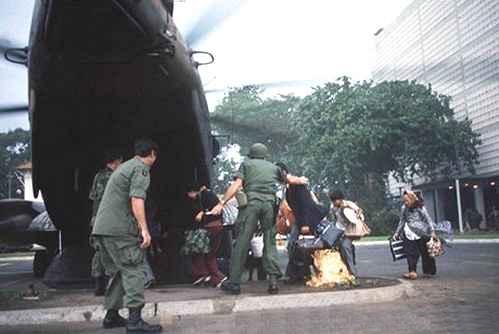
South Vietnamese heading
for the helicopters out of Saigon
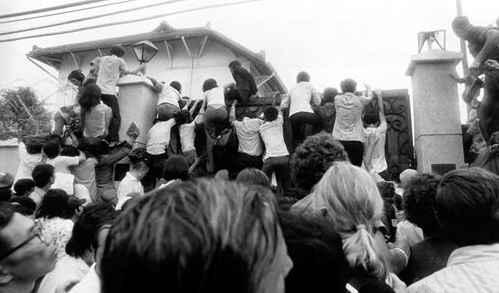
South Vietnamese and Americans
trying to get into the American Embassy compound April 29,
1975
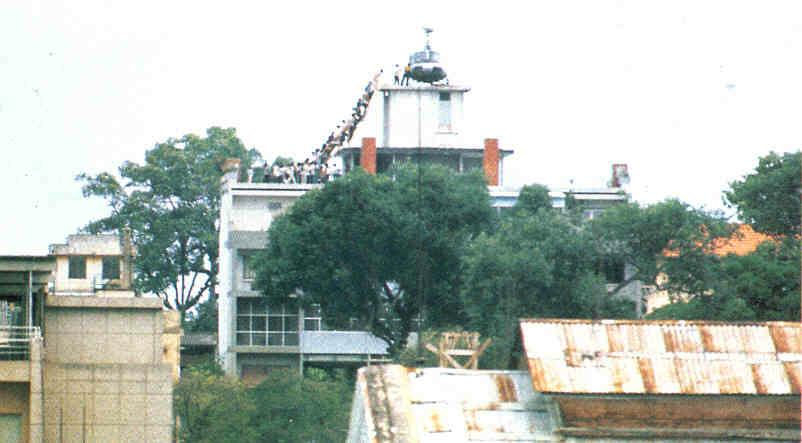
The
Evacuation of Saigon
from atop an apartment building housing CIA employees - April 29,
1975
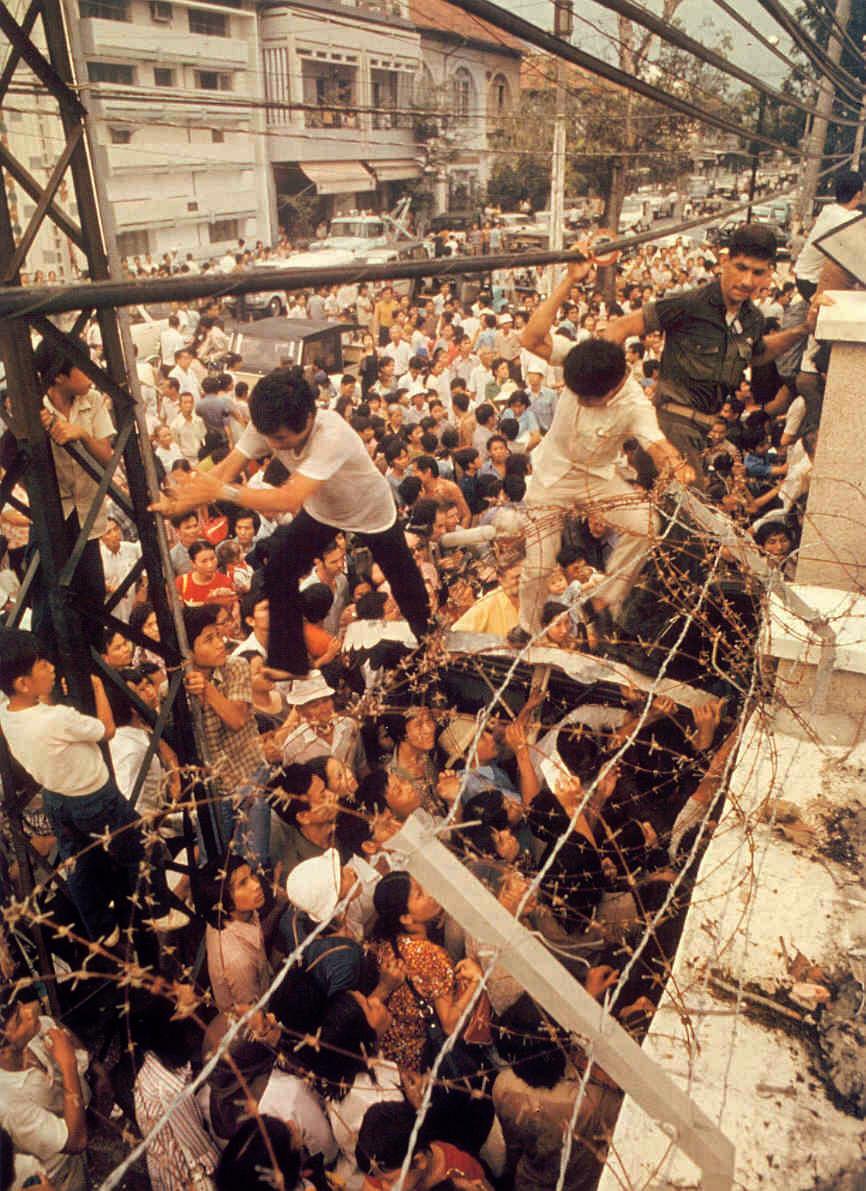
Desperate Vietnamese trying
to escape Saigon with the departing Americans - April 29, 1975
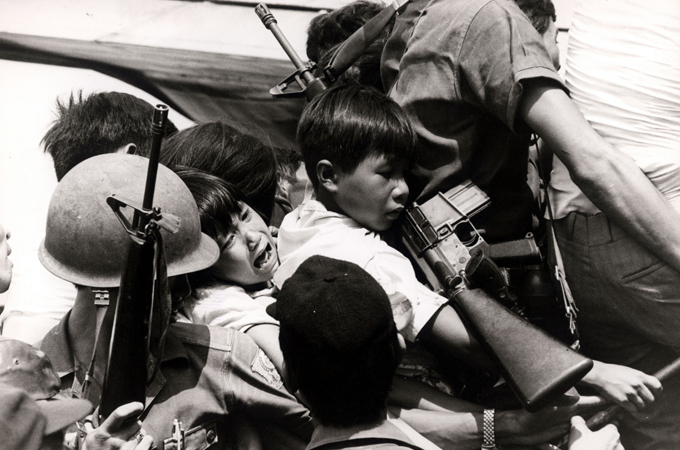 Vietnamese trying to escape
Saigon
Vietnamese trying to escape
Saigon
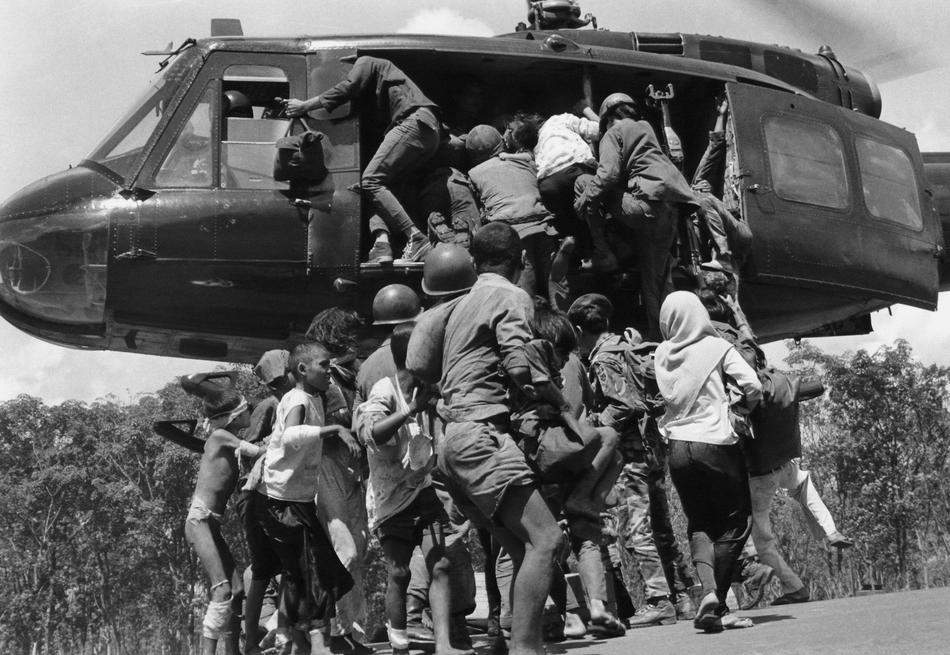
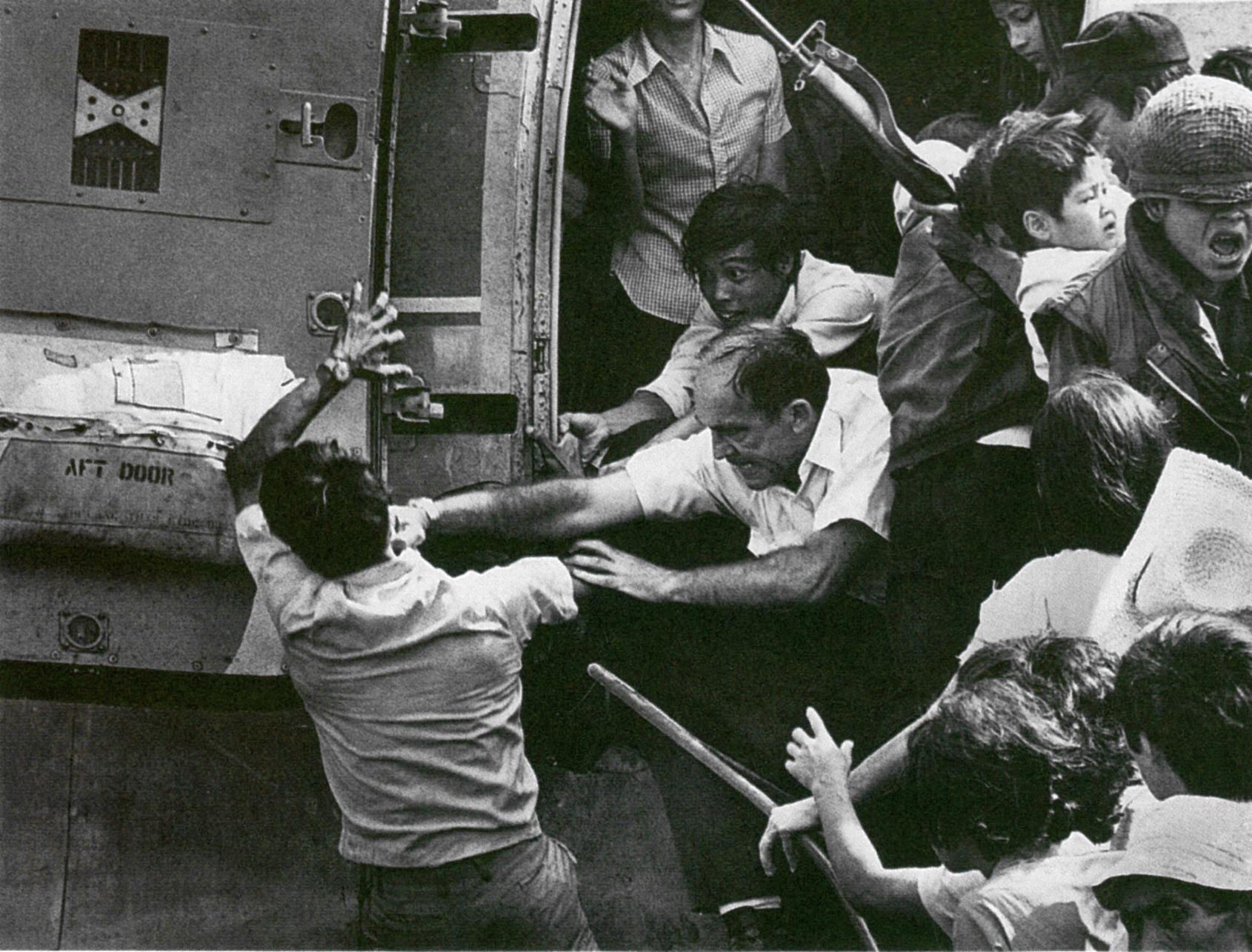
Fending off Vietnamese attempting
to flee Saigon ahead of the Communist takeover - 1975
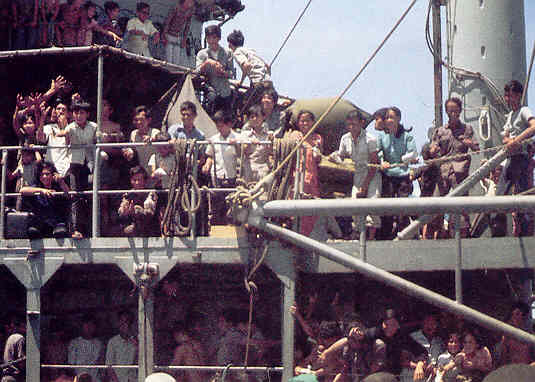
Vietnamese attempting to
escape advancing communists – April 1975
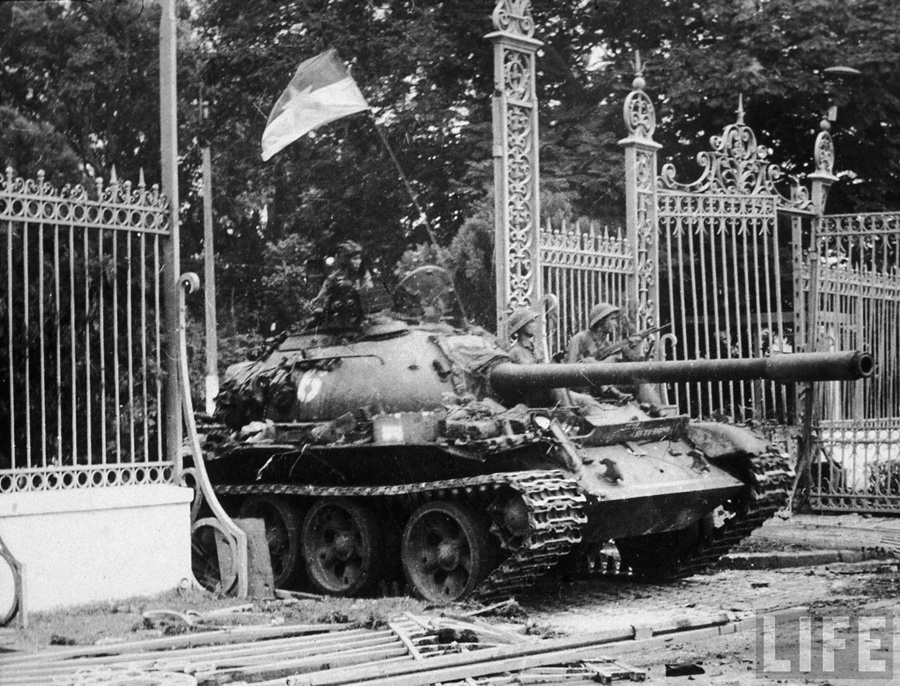
A
North Vietnamese tank breaks
through the gates of the Presidential Palace in Saigon -
April 30,
1975
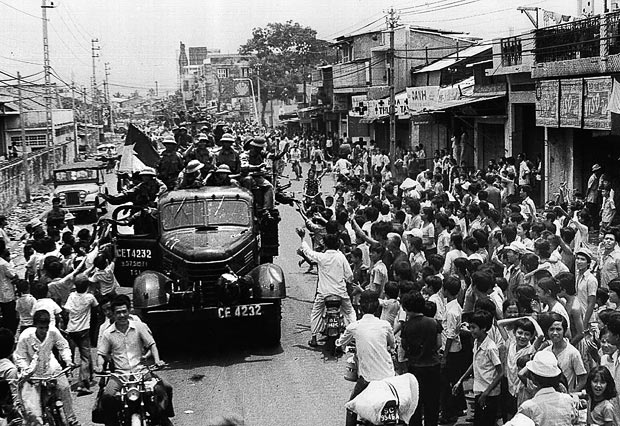
North
Vietnamese troops welcomed into
Saigon
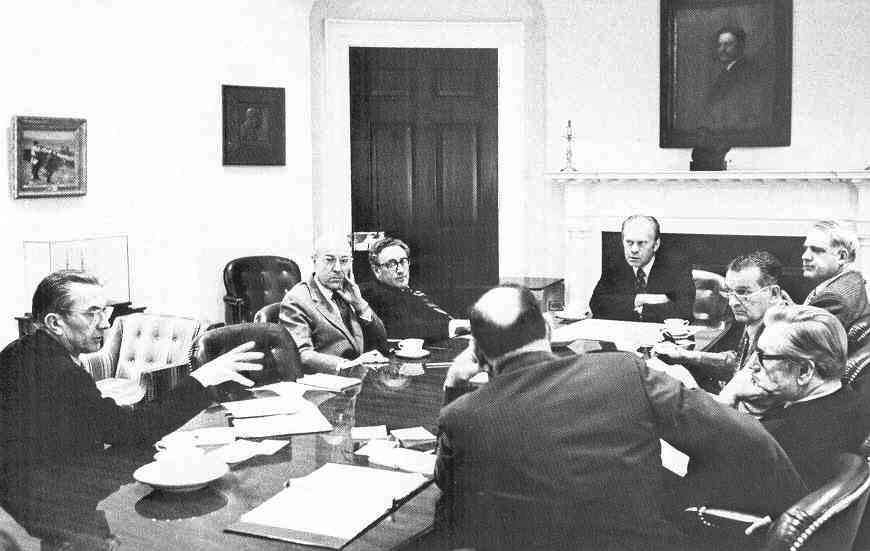
President Ford deliberates
with his National Security Council concerning the fall of Saigon in 1975
The Communist "Re-Education Camps" punishing formerly pro-American Vietnamese
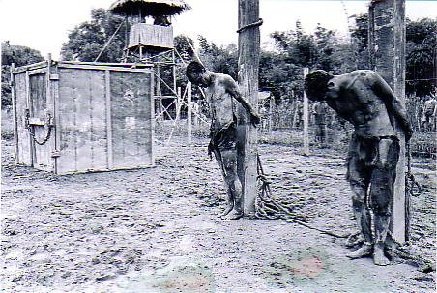
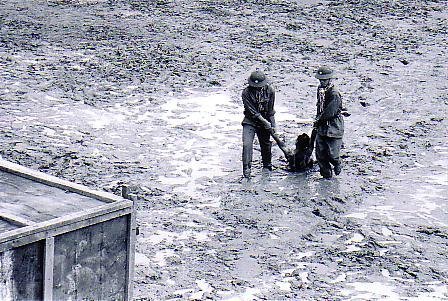
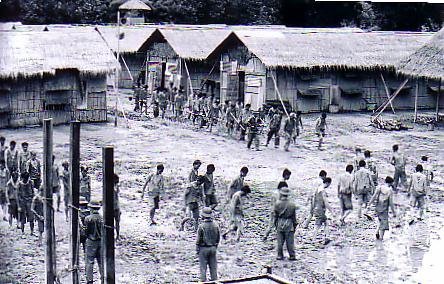
But
next door in Cambodia, the situation became even worse, when the shift
in the regional power picture allowed the Communist Khmer Rouge to take
over "neutral" Cambodia – and impose a Maoist-style regime in the
country … Maoist in the sense that these Communists hated urban society
and were determined to convert all of Cambodia into some kind of rural
paradise, or at least wipe out those elements of urban society unlikely
to make such a conversion. Thus the residents of the capital
city, Phnom Penh, were moved to work camps in the countryside – or were
simply executed on the spot … especially if they were suspected of
being of the intellectual or Westernized variety of citizens.
Of course all of this collapsed the Cambodian economy, producing mass
starvation – and further execution of individuals suspected of
non-cooperation with the Khmer Rouge revolution. Thus were
produced the "Killing Fields" of Cambodia – estimates running from 2 to
4 million Cambodians dying in the process, half by execution the other
half by starvation. |
This "Communist" dynamic also spills directly over into Cambodia
... producing the "Killing Fields" of Cambodia
The
new Communist Khmer Rouge rulers simply exterminate
more than a
million of their own people in order to build a new "purified"
society
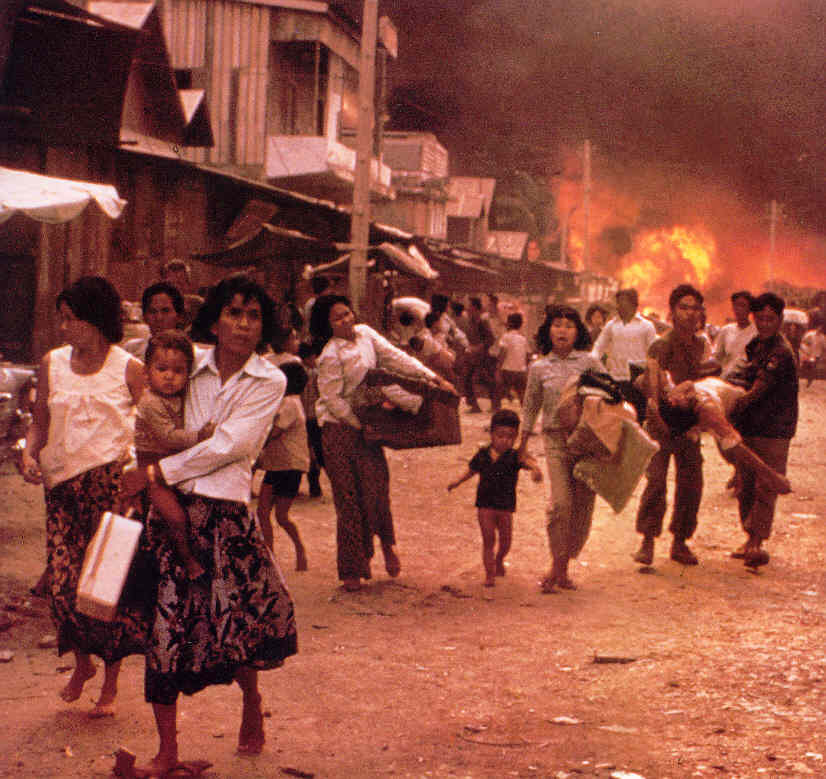
Phnom Penh – Khmer Rouge
attacking the capital where over a million people had sought refuge just as
the Vietnamese Communists were about to overrun Saigon)

Skeletons of Cambodian victims
of the Khmer Rouge, discovered when the Vietnamese
invaded Cambodia – December 1978

A
pile of human bones as
the by-product of the Khmer Rouge's revolution in Cambodia – 1979
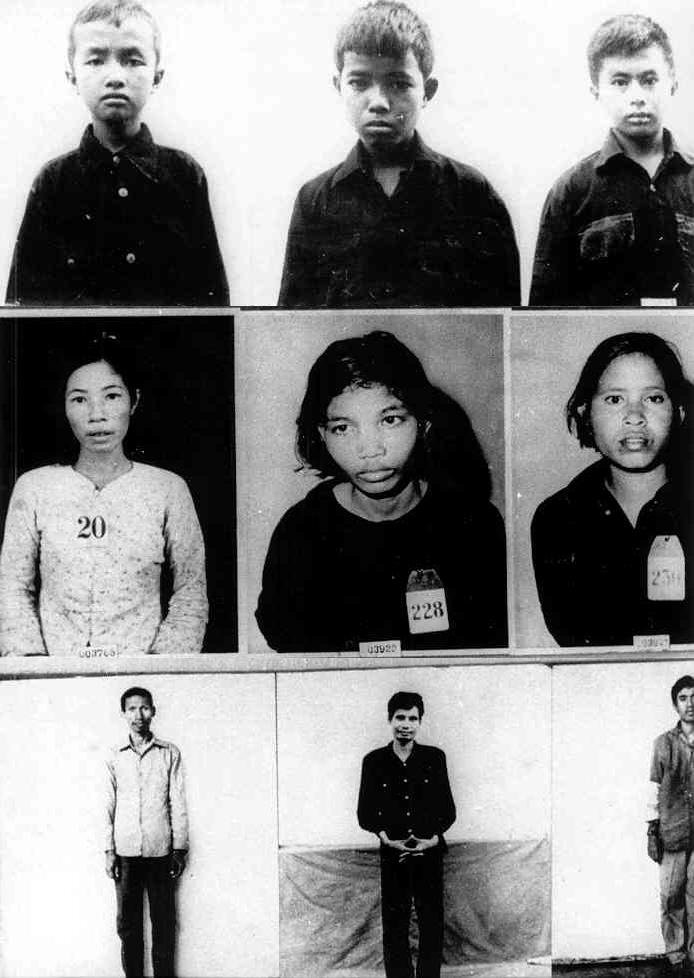
Photo records of the victims of the Khmer Rouge
security police, some of the million Cambodians
slaughtered by Pol Pot's Communist regime – 1975
The "boat people"
| By
1978-1979, millions of Vietnamese (and others) were trying desperately
to escape the horror that had descended on their world, some heading
overland in their effort to escape to Malaysia or Thailand but most
simply taking boats and heading to the open sea in the hopes of being
picked up by passing Western ships. Tragically, many died in the
effort. But ultimately some 800,000 "boat people" were picked up
… and settled in America. Another quarter million were able to
get to Europe or Britain’s Commonwealth countries and to settle there.
|
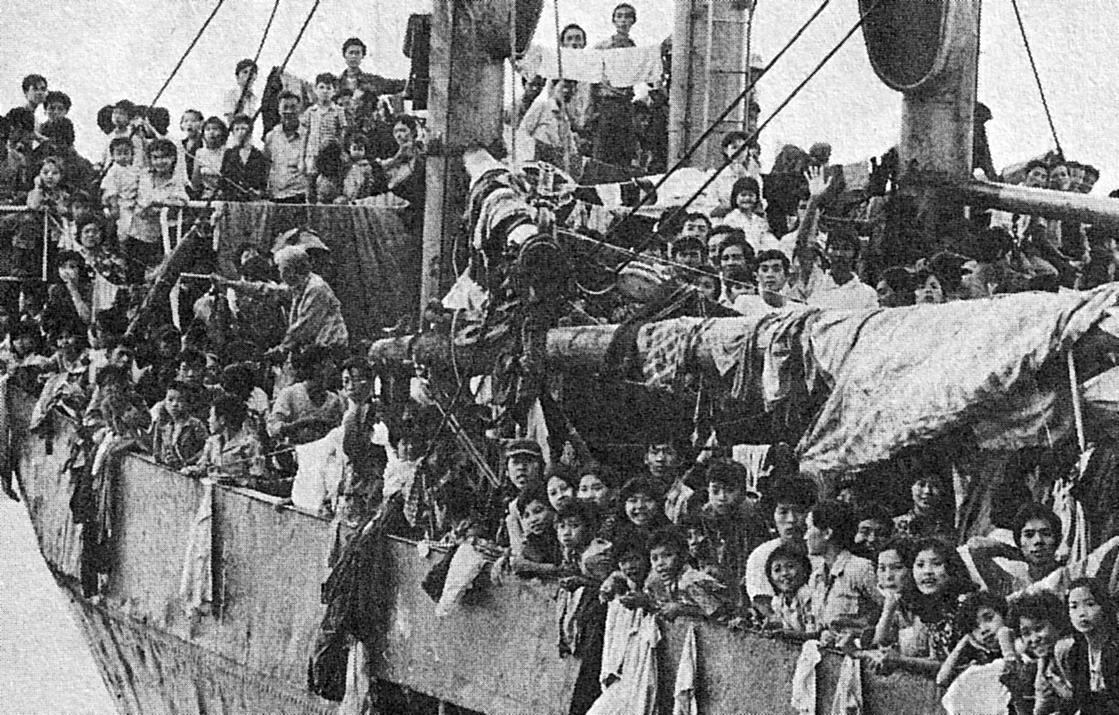
Vietnamese "boat people"
seeking escape from Vietnam
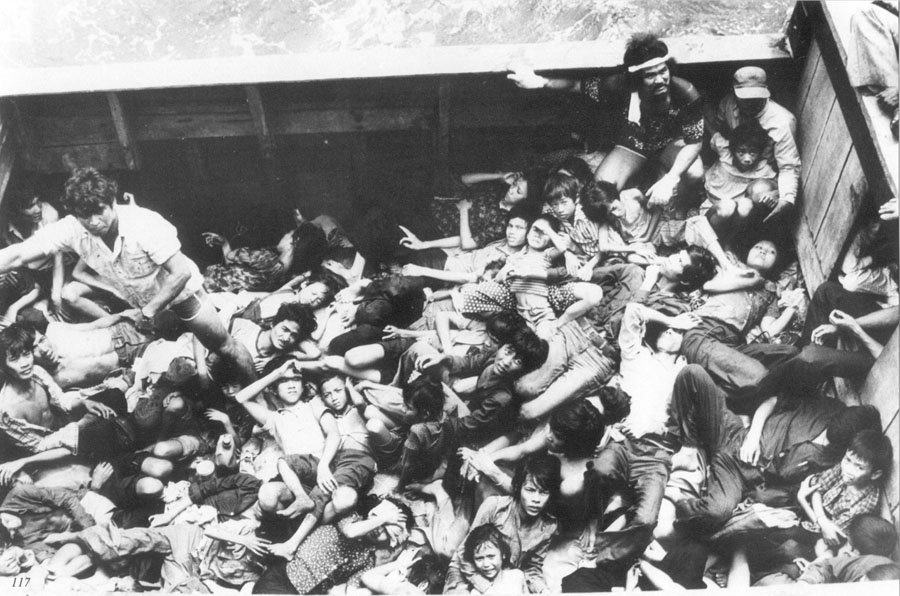
But so many of them did not
make the journey successfully.
Tragically, so many of them will die at
sea.
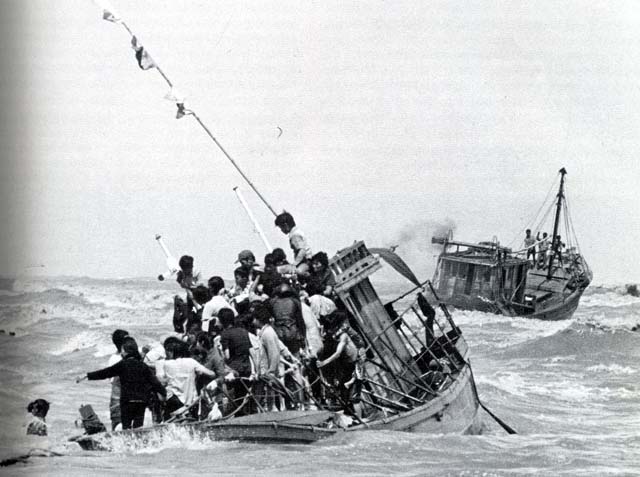
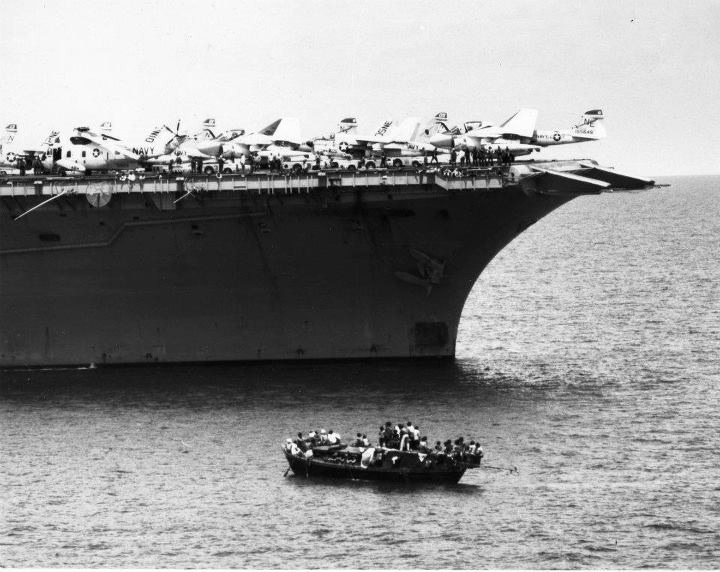 Some, however, will be
fortunate enough to be picked up by friendly ships 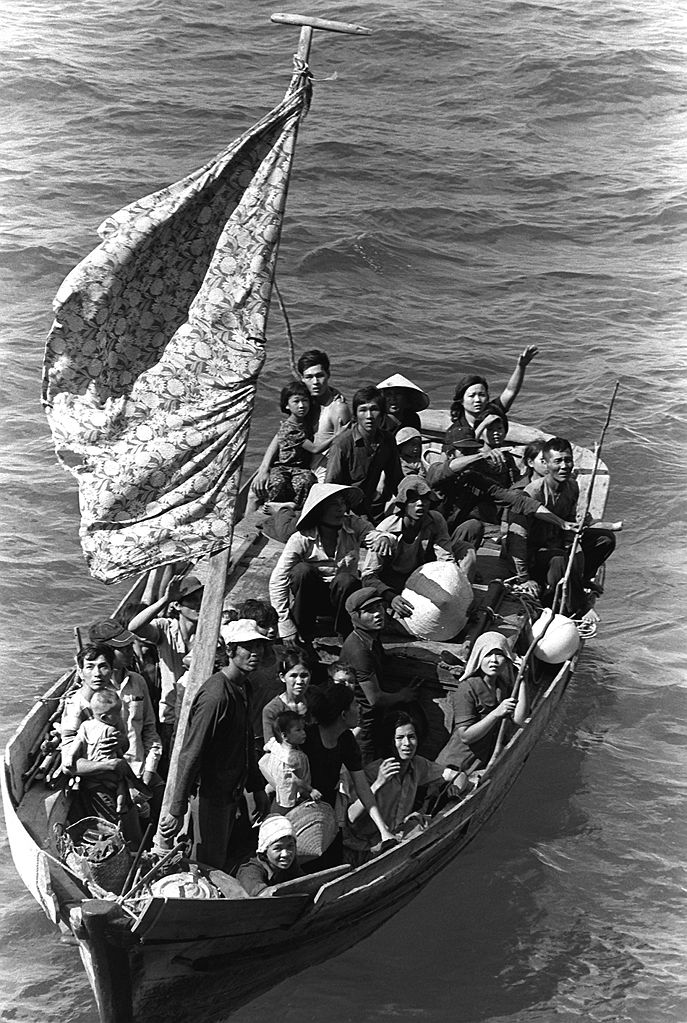 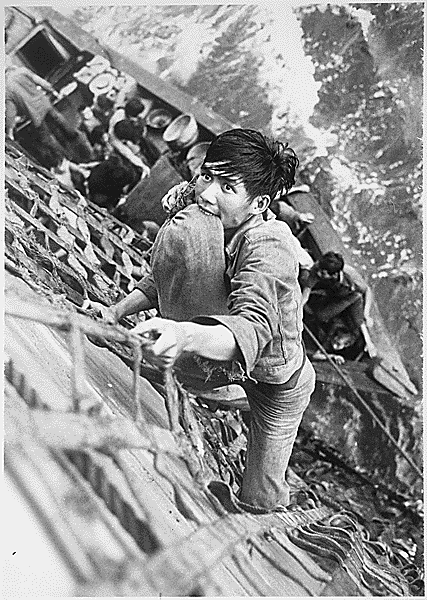
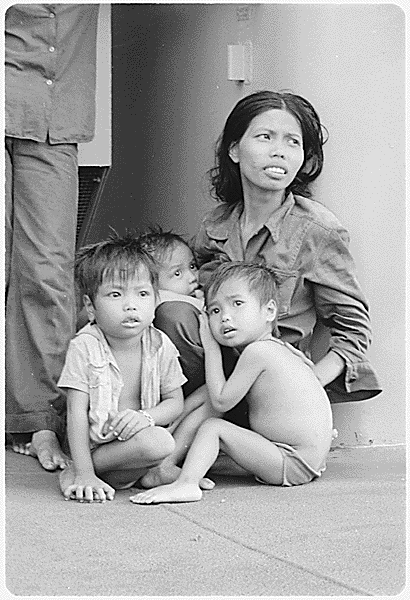
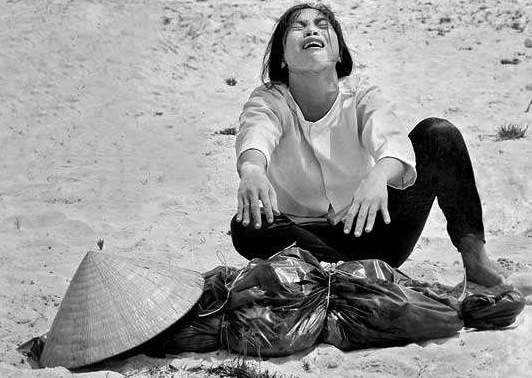 While Vietnamese were
taking to the sea to escape Vietnam, many others fled overland to surrounding
countries ... with similarly tragic results 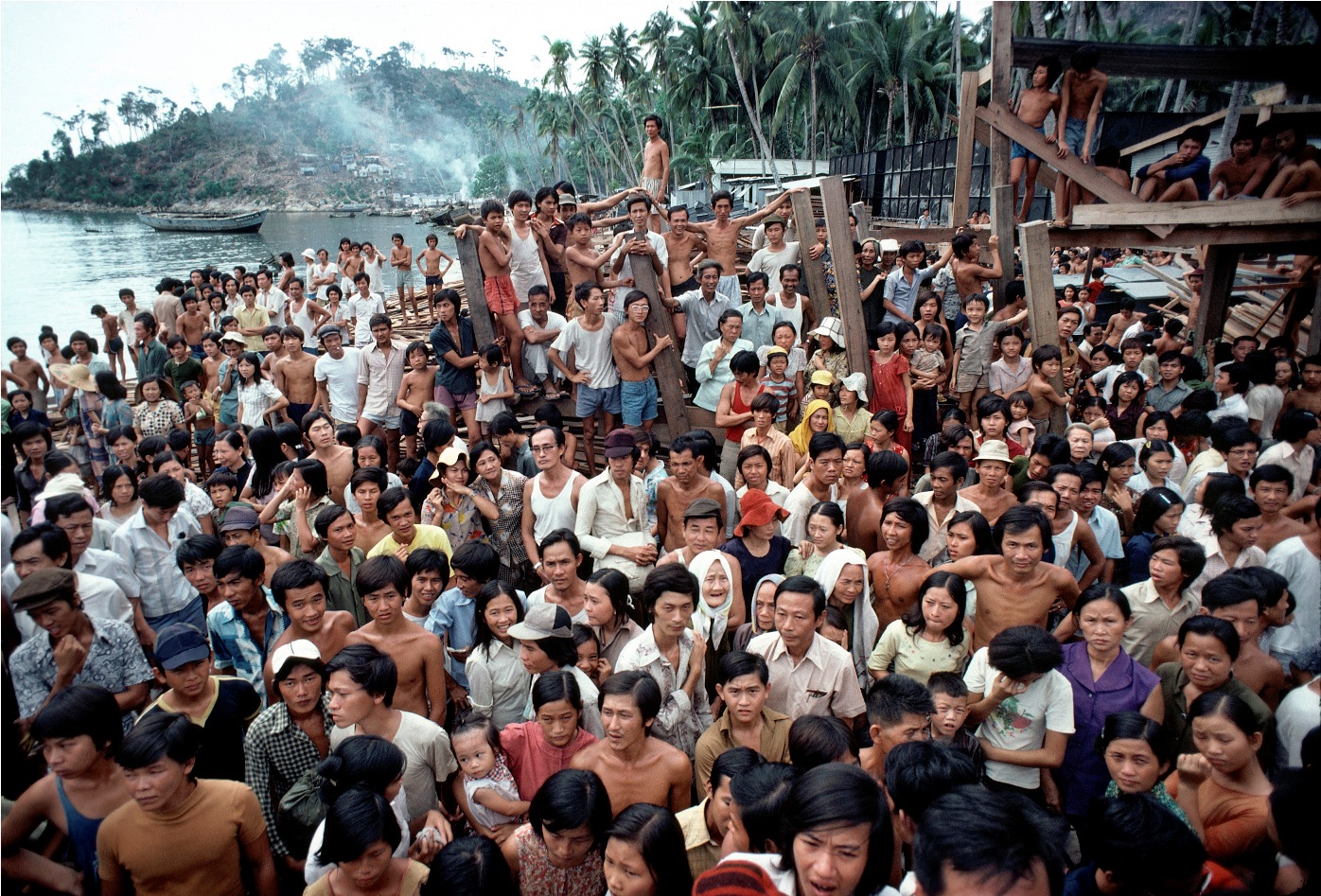
Many made it to overcrowded refugee camps of neighboring
countries ... such as the Pulau Bidong Island Camp in Malaysia
where
some 36,000 were located as of this 1979 photo.
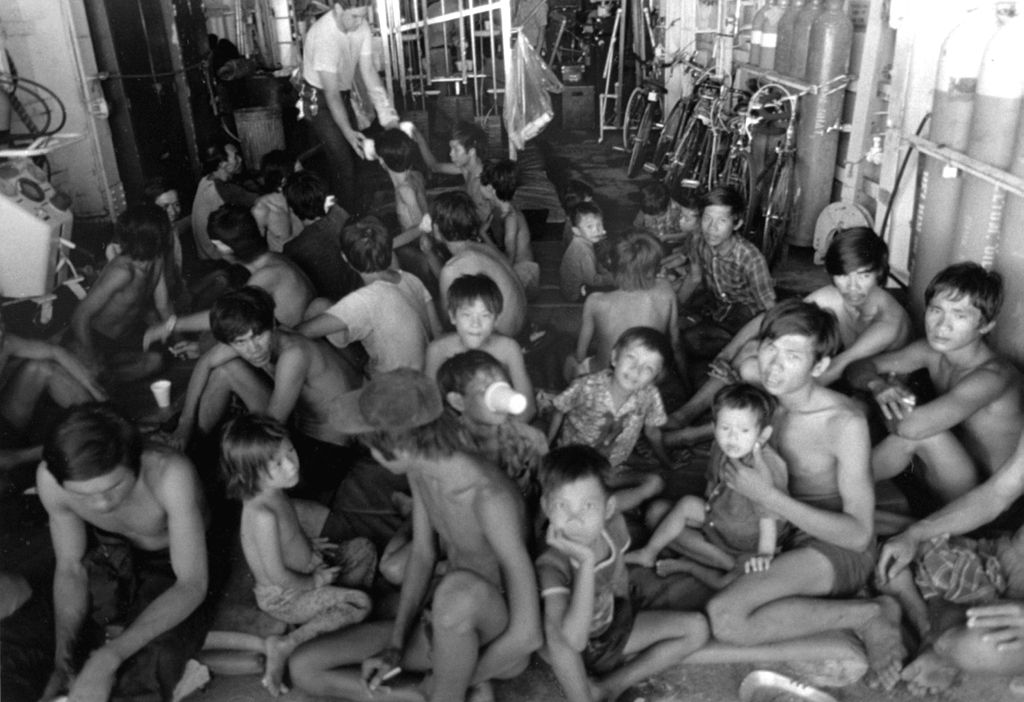
Vietnamese refugees
rest as crewmen aboard the guided missile cruiser USS FOX (CG-33) give them something to drink
- 1 June 1982
|
Evaluating it all
Did Congress ever acknowledge its role in starting up this catastrophe
with its abandonment of its South Vietnamese ally? The answer to
that is a very clear "no." This was not a matter that Congress –
or any of the American Left – wanted to bring up for discussion.
So the whole tragedy was simply ignored by those now directing
superpower America.
A VERY SAD AMERICAN BICENTENNIAL (1976) |
Certainly
a huge effort was undertaken to make the celebration of America's 200th
year since the signing of its Declaration of Independence as grand an
event as possible. But it was just too hard to wipe away the
sentiment that something was deeply wrong with America. Yes,
America had come a long, long way in its development over those 200
years. But the last decade had been confusing … and at times just
highly dispiriting.
Anyway, another national election was coming up that November, and the
necessity of finding a leader to take America forward seemed more
important that simply celebrating the past.
|
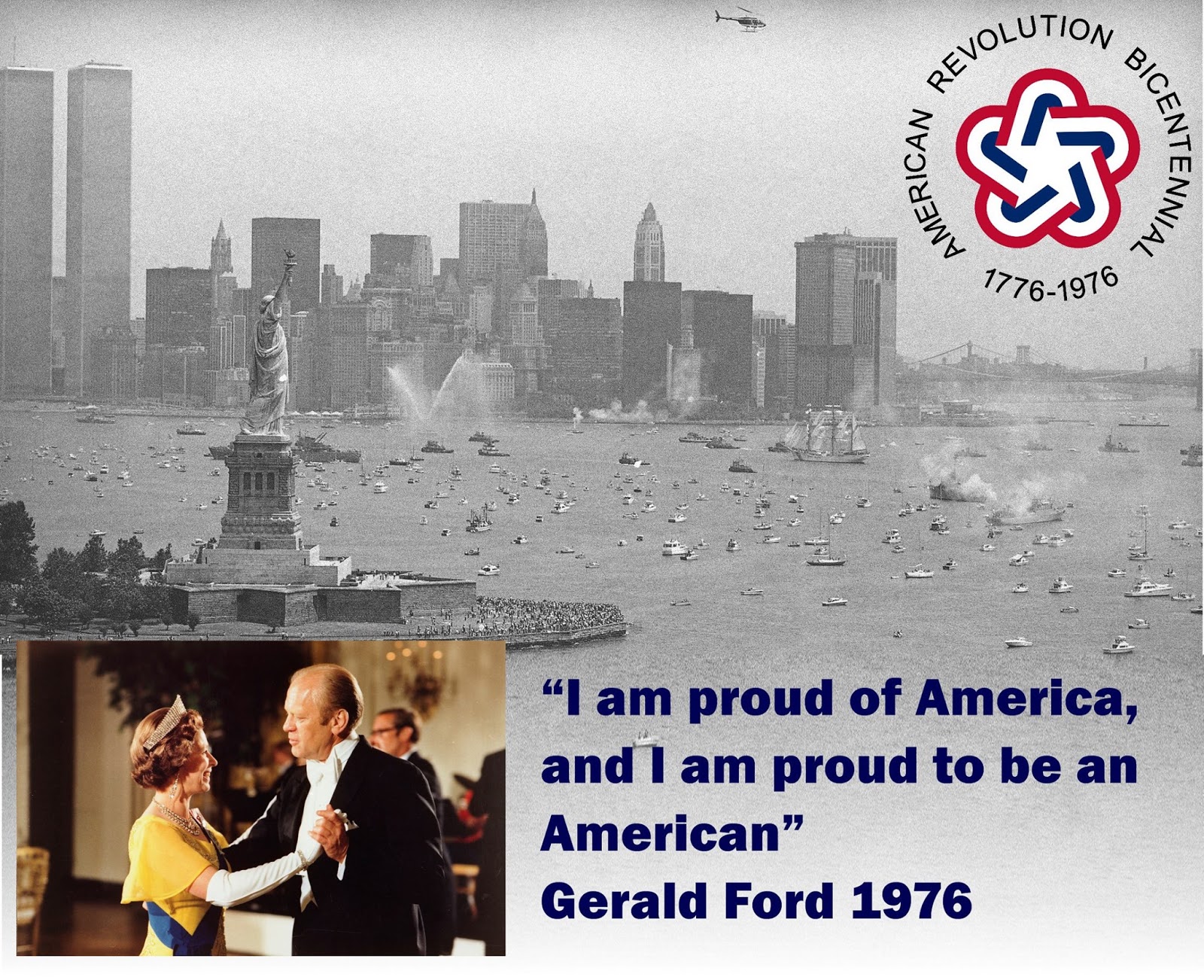
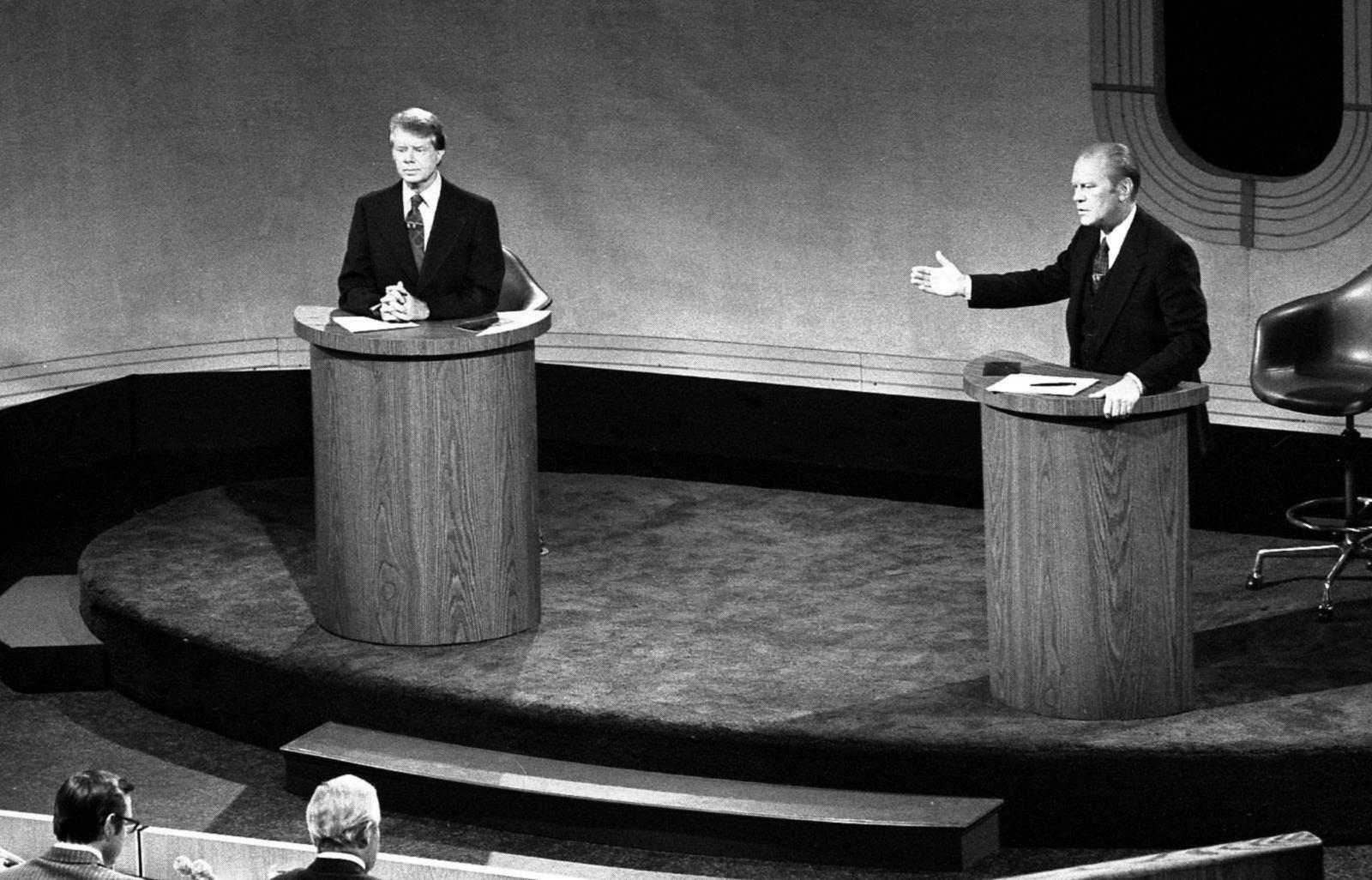
Governor Jimmy Carter
and President Gerald Ford debating
at the Walnut Street Theater in Philadelphia.
- September 23, 1976
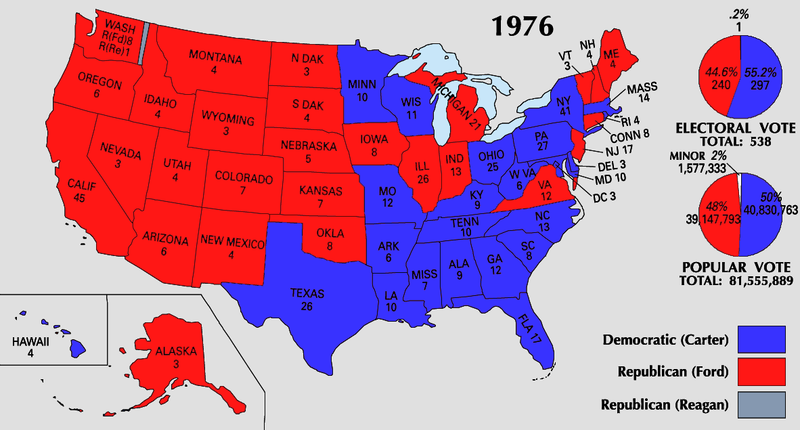
The 1976 Presidential Elections
The Democratic Party "Progressives" now control all of Washington politics
AMERICA MOVES FROM CHRISTIANITY TOWARDS SECULARISM ... AS THE NATION'S MORAL-SPIRITUAL FOUNDATION |
|
America heads down the Secular road
… with the Supreme Court leading the way
The Constitution that the American Republic officially brought into
being in the late 1700s spelled out a very limited government, one
designed simply to keep the 13 now-independent American states joined
together in a new Federal union … and moving together (not in
competition with each other) down the road of independence that they
had maintained – even against British efforts to end that independence
– at that point for a century and a half. The Constitution spells
out no moral-religious conditions for its existence … though it was
well-testified at the time that American society itself was understood
to stand on strong Christian moral-spiritual roots. Indeed, the
First Amendment, demanded by America's leaders as a condition of
acceptance of the Constitution, spells out very clearly that Congress
was to make "no law respecting an establishment of religion or
prohibiting its free exercise" … the very first of the freedoms
guaranteed in the First Amendment. America's religion belonged to
the people … not to Congress (meaning also, any Federal
authority). And that's where things stood in America … all the
way up until the beginning of the 1960s.
As we have seen, the ACLU took it upon itself to go – not to Congress
but to the Supreme Court – to begin its campaign to replace America's
Christian moral-spiritual foundations with the "religious Humanism" (to
quote the Humanist Manifesto
of 1933) as the nation's moral-spiritual foundations. Of
course the ACLU no longer called its religious ideology "religious
Humanism," but posed itself as the voice of "science" rather than
"religious superstition." In any case, according to the ACLU, God
had no place in America's public life.
Thus in 1962 it got prayer in the nation's public schools shut down by
the Supreme Court … and in 1963 the reading of the Bible, a sacred
document that had long formed the moral-spiritual instruction set that
America was built on. And it got a "Progressive"
(Democratic-Party-controlled) Congress and a naive Christian leadership
to undercut any effort by way of a further amendment of the
Constitution, an amendment seeking to make absolutely clear what the
First Amendment meant by "no law … prohibiting its free exercise" …
which is exactly what the ACLU succeeded in getting the Supreme Court
to do: prohibiting – by the Supreme Court's own self-assumed
law-making powers – religion's free exercise.
But the matter did not stop there. In 1971, the Supreme Court
overturned the decision of a lower court that public funds used in
Pennsylvania to pay for textbooks in Catholic schools did not violate
the constitution, the Supreme Court instead deciding in the Lemon v. Kurtzman
case that in fact this activity violated the Jeffersonian "separation
of church and state" principle of the First Amendment. But the
Court went further in specifying (the famous "Lemon test") that the
government can act only when such action serves a purely "secular
legislative purpose" … in order to avoid "an excessive government
entanglement with religion."
In short, a secular purpose rather than a Christian purpose was to
guide American education. But Secularism is a worldview or
religion like any other … specifying the basic Truths that guide all
existence – Truths that people believe in and live by as the
fundamental principles of life. By the design of the American
people themselves, Christianity used to play that role … and led a
Christian America forward over the centuries to rather grand success as
a thriving democracy. But now – according to the authoritative
ruling of the Supreme Court – only Secularism can play that role.
That action by the Supreme Court supporting Secular principles in
opposition to Christian principles was therefore the equivalent of
enacting a law "respecting an establishment of religion" (Secularism) …
as well as prohibiting the "free exercise" of America's long-standing
religious traditions – both actions expressly forbidden by the
Constitution, a Constitution that the Supreme Court was supposed to be
upholding … not amending or revising along political-ideological lines.
In short, the vital moral idea of a God who clearly had guided previous
American generations – and most importantly its leadership – was now
NOT to be taught – or even mentioned – to any rising American
generation in its schooling.
Enjoying a great victory, but nervous that its support of "religious
Humanism" in the 1930's Humanist Manifesto, would get it in trouble,
Humanists were quick to authorize a Humanist Manifesto II in 1973 … a
new document that declared that its Humanist principles were secular
and thus scientific – not religious.
But this would not be the end of the momentum in which American
"Progressives" would act to replace Christian religious principles with
Secular-Humanist religious principles. |
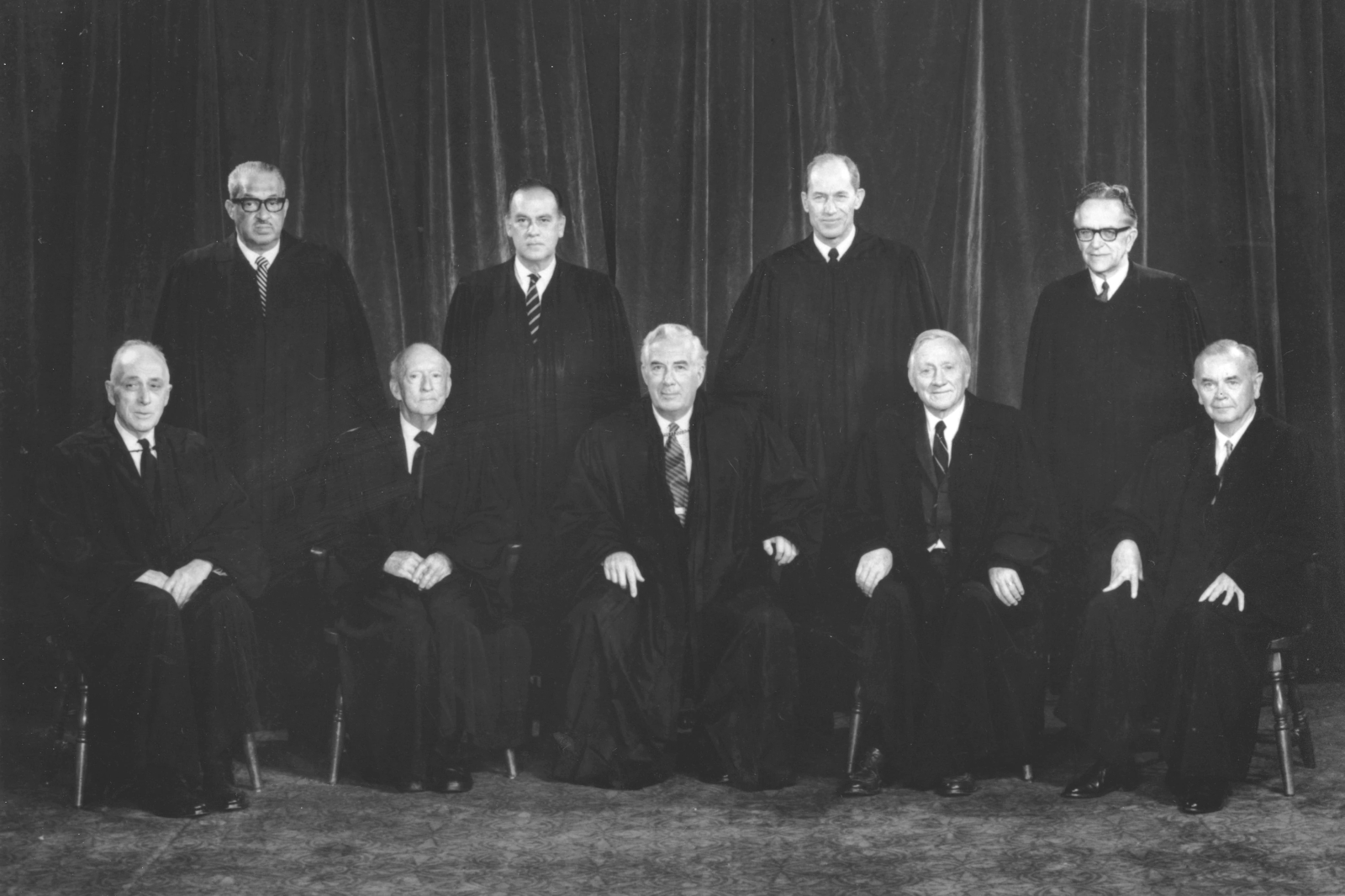
The very "Liberal" Warren Burger Supreme Court
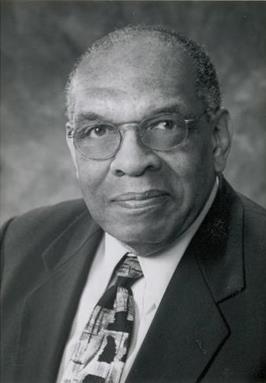
Alton Lemon (above) was named as the leading plaintiff in the suit against the Pennsylvania Superintendent of Public Instruction of Pennsylvania, David Kurtzman (below) for his (actually his Office's) support of religious schooling.
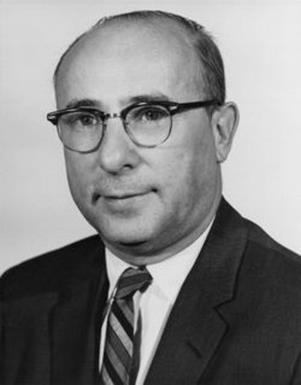

Go on to the next section: Very Positive Developments in Europe
 Miles
H. Hodges Miles
H. Hodges
| | | | | |


 The European Economic Community
The European Economic Community The American retreat from Vietnam
The American retreat from Vietnam
 Vietnam Veterans Against the War
Vietnam Veterans Against the War
 Détente with the Chinese and Soviets
Détente with the Chinese and Soviets
 Another Arab-Israeli War (October 1973)
Another Arab-Israeli War (October 1973)
 Congress brings down Nixon – and
Congress brings down Nixon – and The horrible aftermath of Congress's
The horrible aftermath of Congress's A very sad American Bicentennial (1976)
A very sad American Bicentennial (1976)
 America moves from Christianity
America moves from Christianity President Nixon and troops
in Vietnam
President Nixon and troops
in Vietnam





 Actress "Hanoi Jane" Fonda
visiting North Vietnam
Actress "Hanoi Jane" Fonda
visiting North Vietnam 















































































